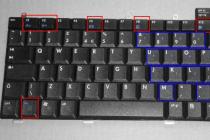It will start selling the latest flagships Galaxy S8 and S8 +, which at first glance were impressive only with a new display proportion and, as a result, smaller dimensions with huge screens. The display is important, but besides this indicator, there are many other aspects that affect the perception of the device, and the matrix almost covers the entire front panel - is it convenient? the site got acquainted with a more compact modification of the flagship, the Galaxy S8, and figured out what the manufacturer did well, and where there is still work to be done.
Specifications Samsung Galaxy S8
- screen: Super AMOLED, 5.8 inches, resolution 2960 × 1440 pixels
- platform: 8-core Exynos 9 Octa 8895
- RAM: 4 GB, ROM: 64 GB (+ microSD)
- Main camera: 12 MP, f/1.7, front camera: 8 MP, f/1.7
- Wi-Fi 802.11 a/b/g/n/ac, Bluetooth 5.0, USB Type-C, GPS (support A-GPS), GLONASS
- battery: 3000 mAh
- fingerprint scanner, iris scanner, accelerometer, light sensor, proximity sensor, IP68 protection
- dimensions: 148.9 × 68.1 × 8.0 mm, weight: 155 g
- OS: Android 7.0 Nougat
Appearance
samsung galaxy S8 was the development of ideas Galaxy design S6 edge and S7 edge, and also absorbed the best features of Note7: a metal frame around the perimeter, the standard arrangement of all controls, the glass front and back is curved closer to the ends, while the bend turned out to be symmetrical. The black version of the device offers an almost perfect match to the color of both the metal and the glass substrate, even the glossy effect is the same at a cursory acquaintance.
1 of 14
Samsung Galaxy S8

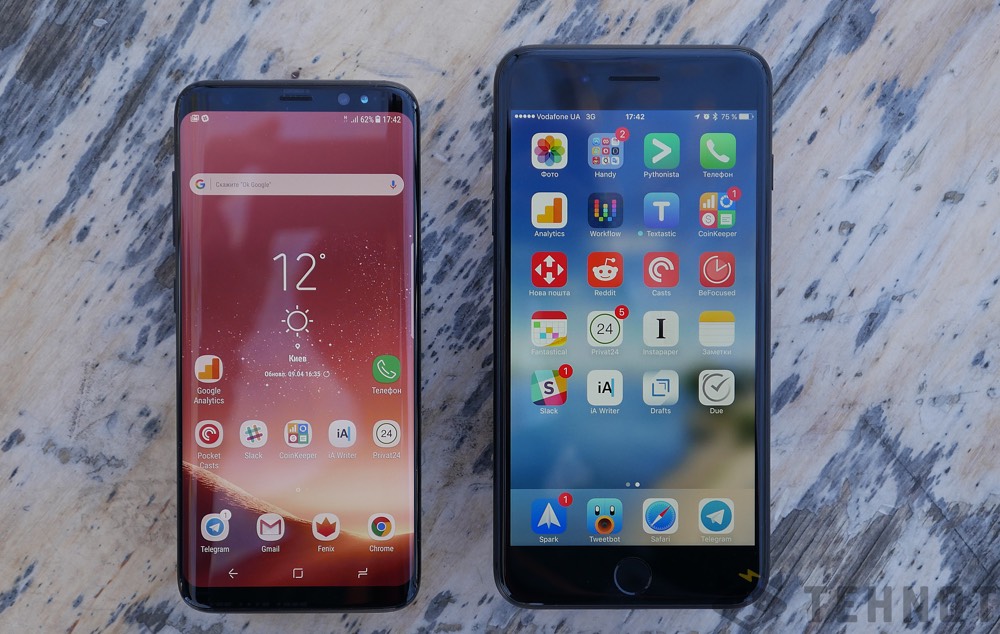
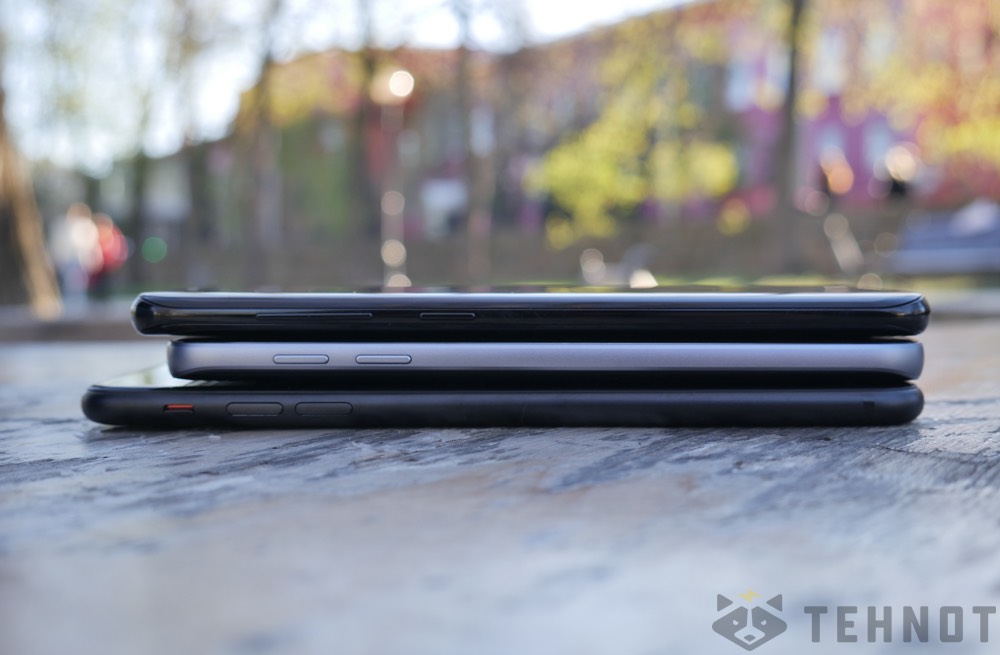
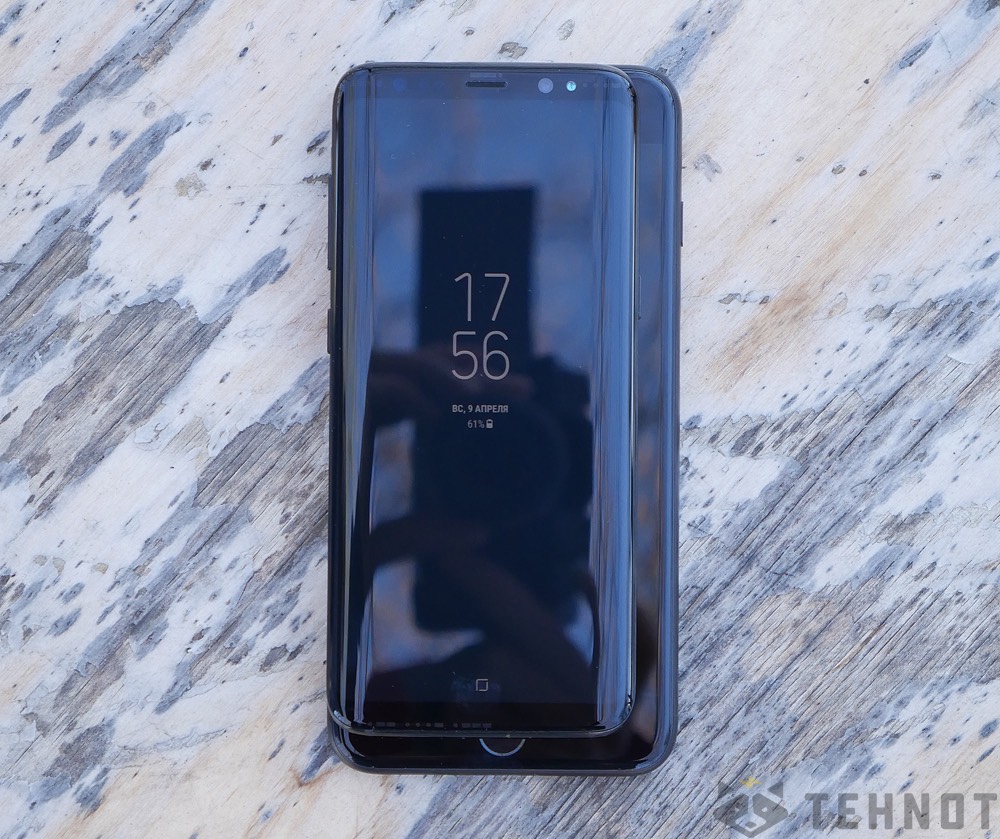

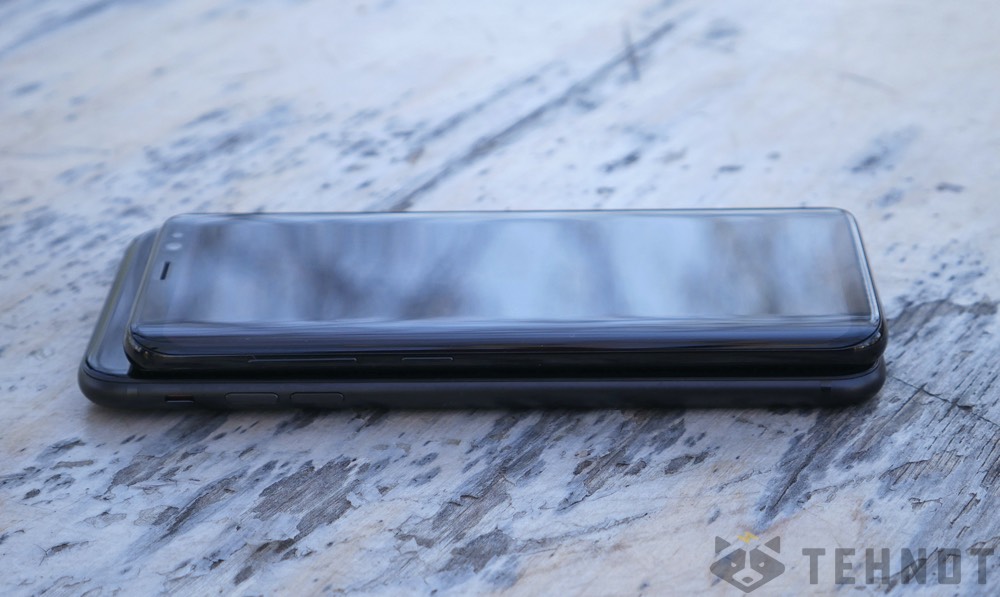
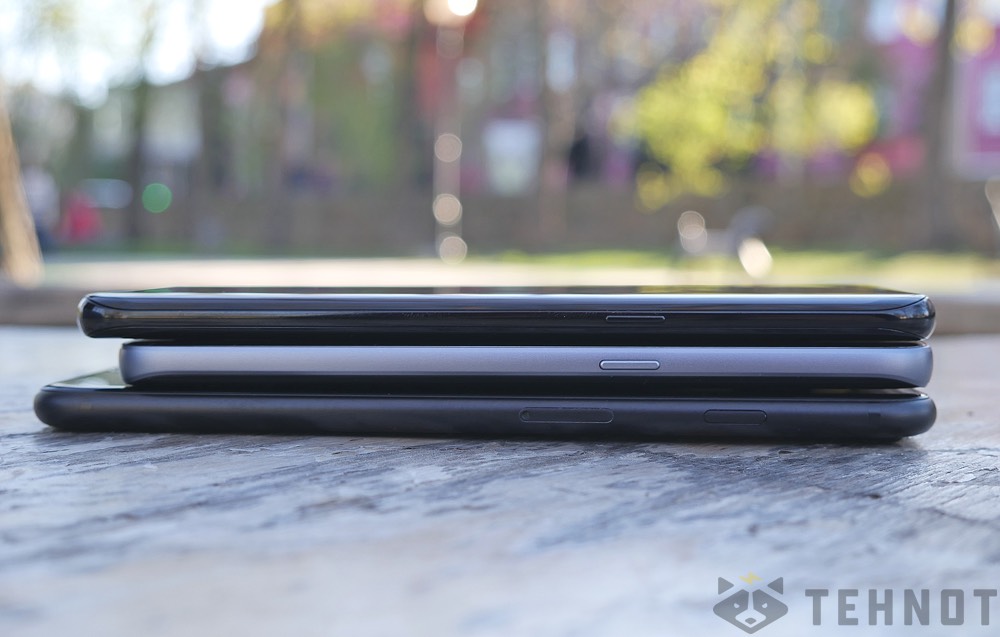
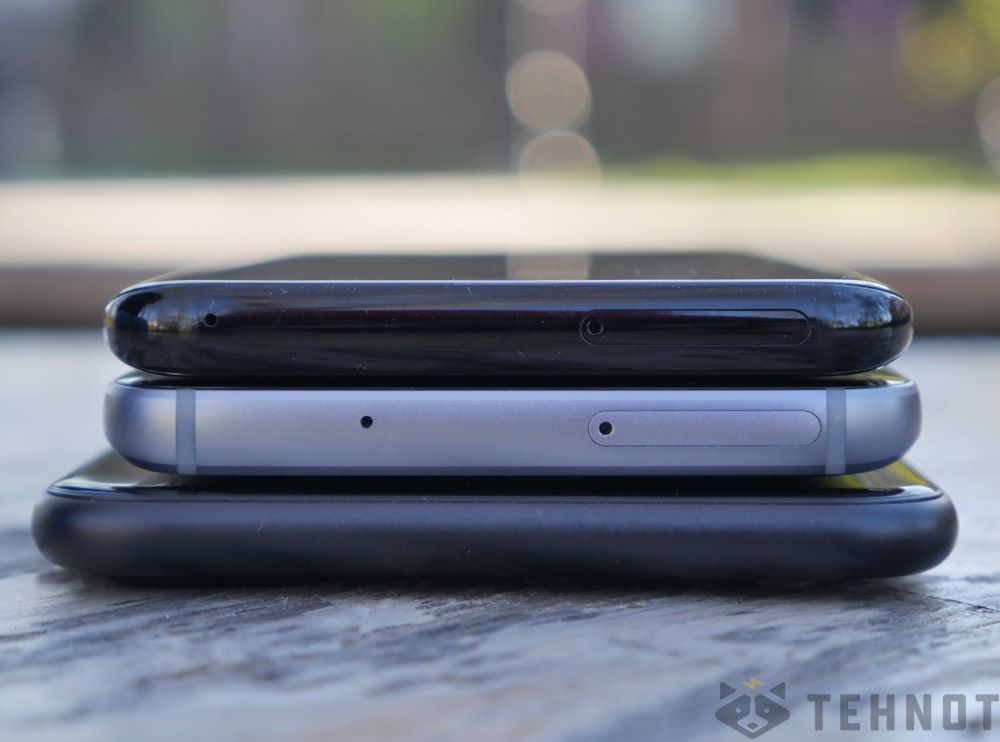
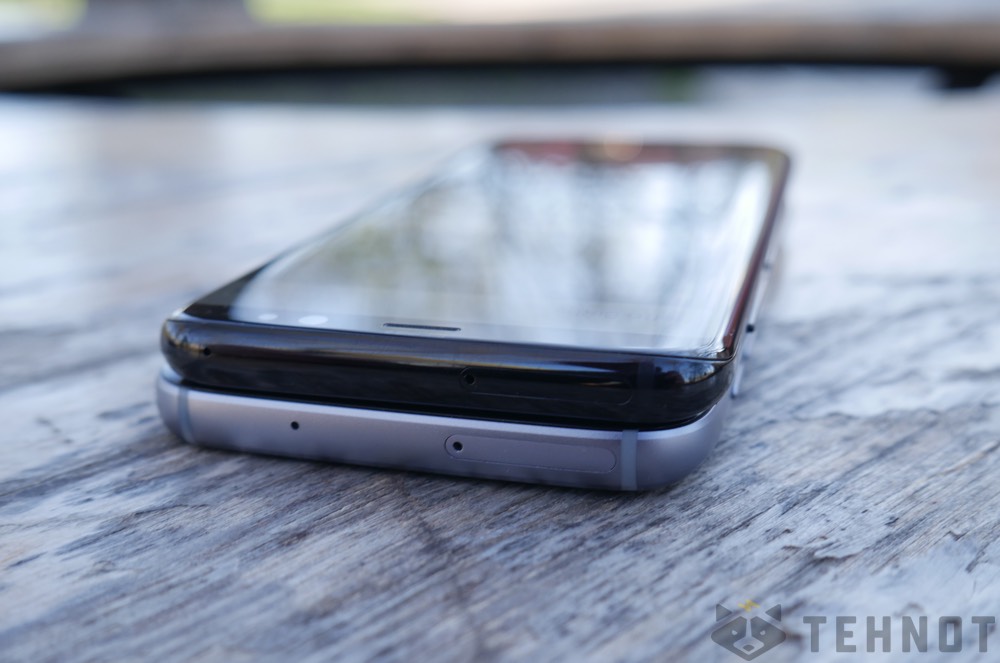
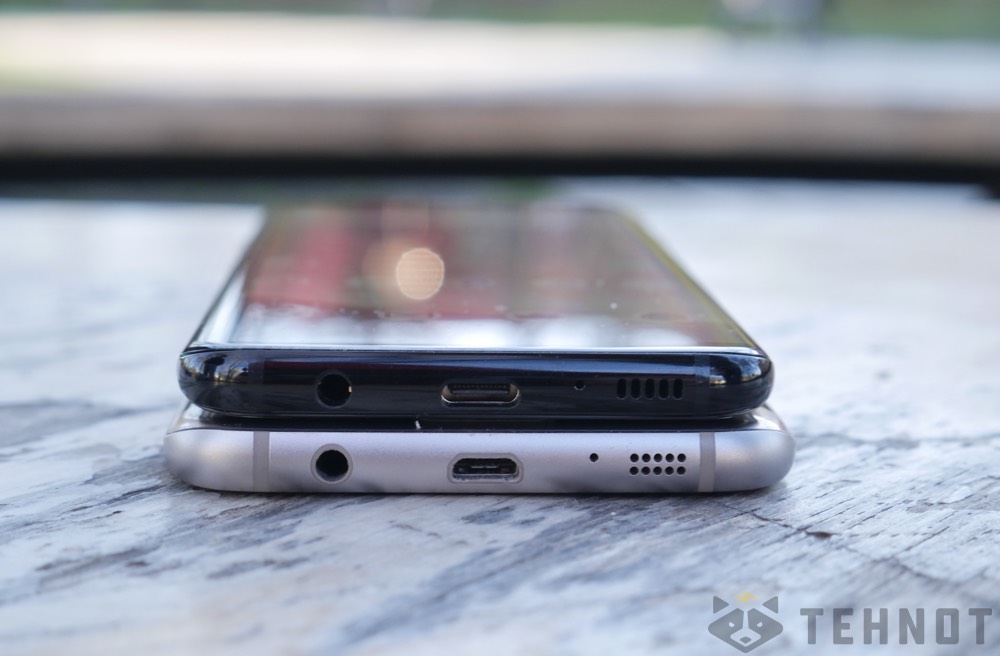
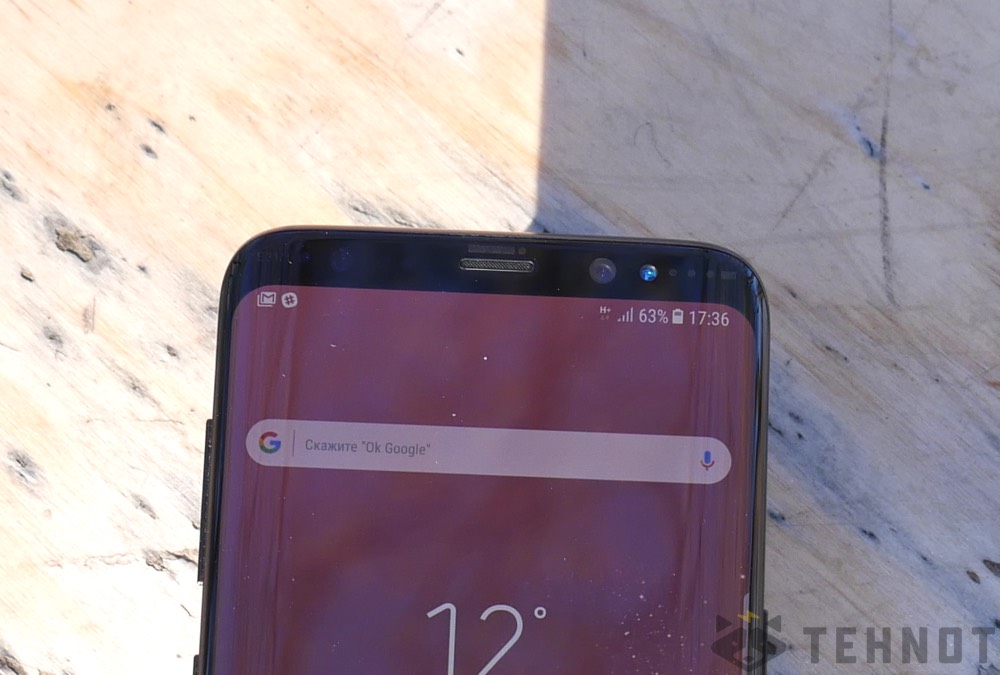
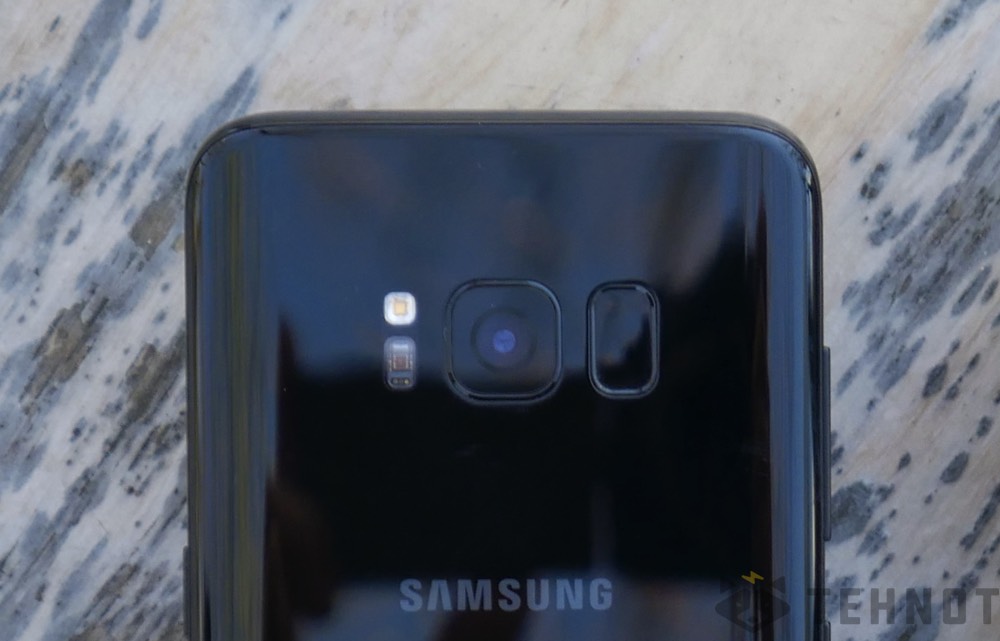
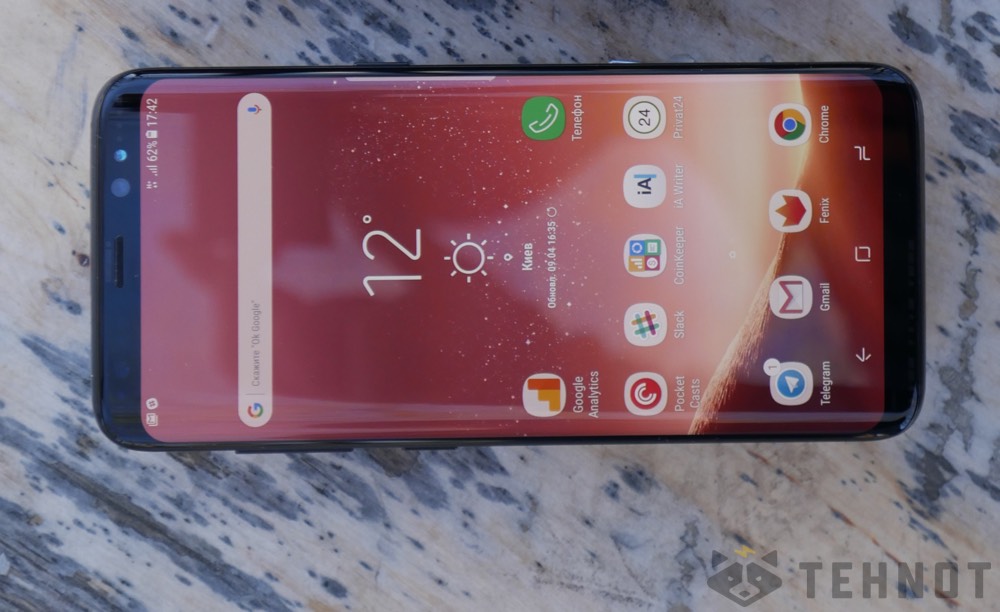
The device looks spectacular, besides, there is no manufacturer's logo on the front panel - this immediately makes the smartphone more pleasant for aesthetes, and also makes it clear that the manufacturer has found the design that consumers can unmistakably recognize even without a nameplate. The premium is visible and felt, which is important for a smartphone priced at UAH 25,000.
1 of 4
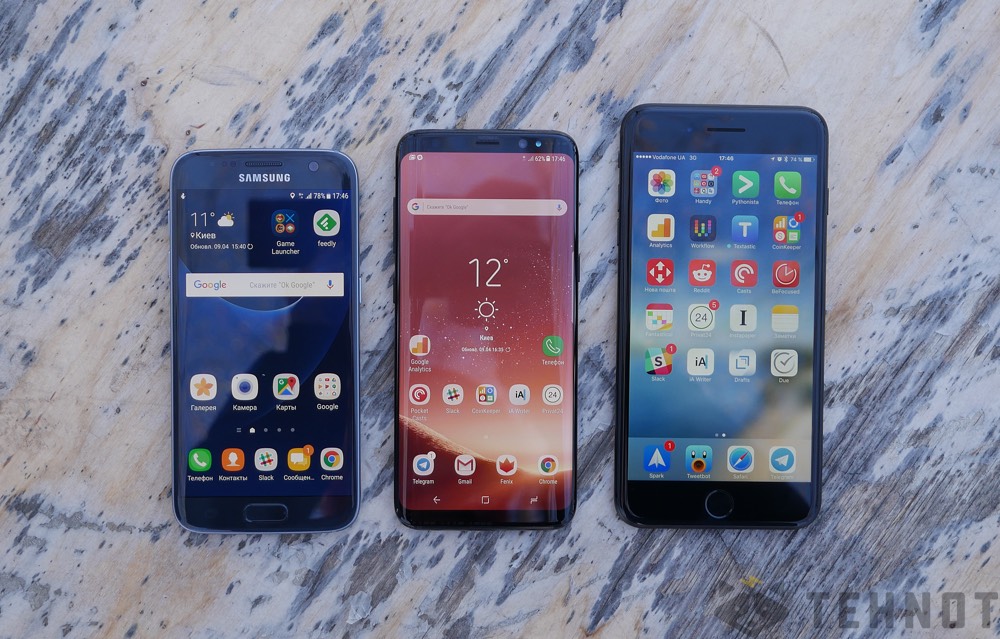
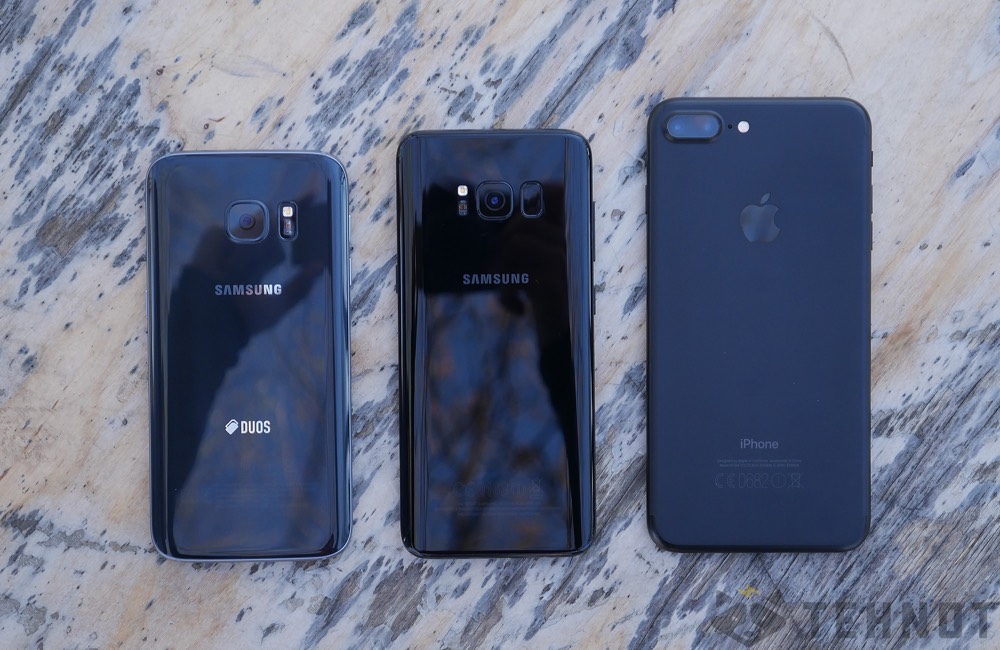
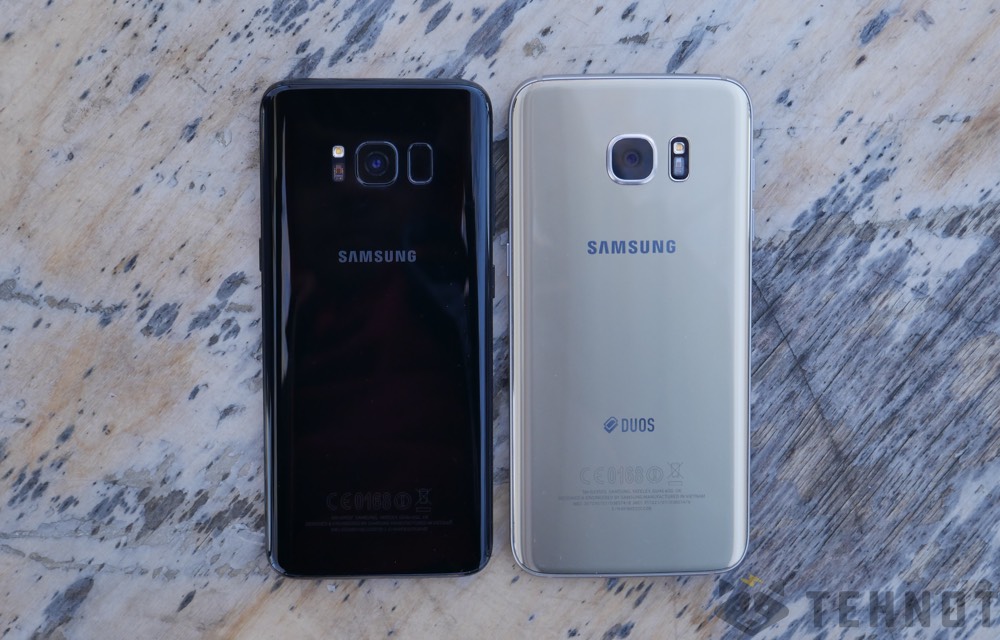
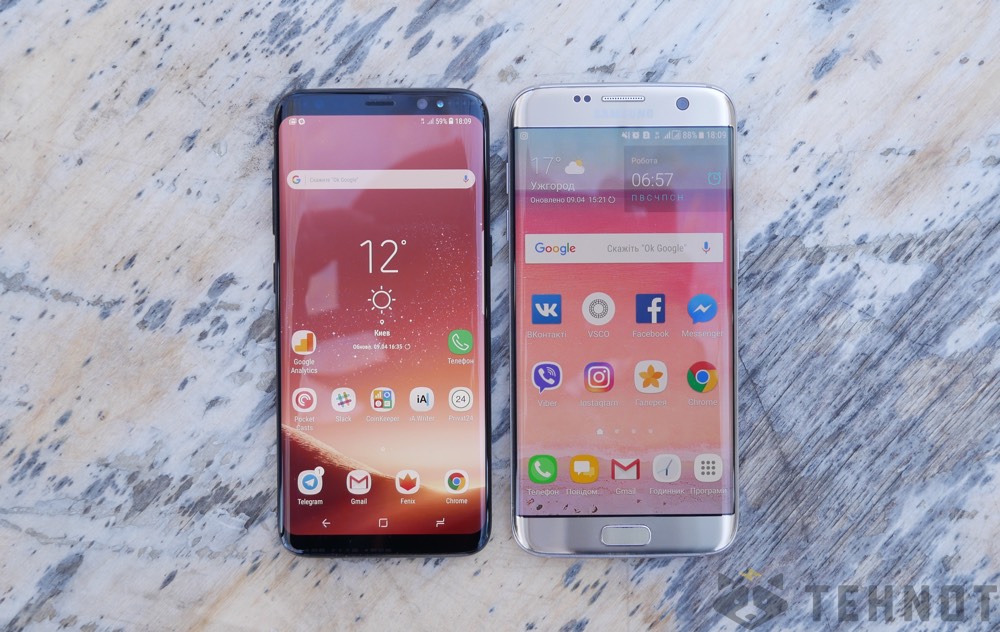
Samsung's new generation of flagship smartphones are only available in a curved display version for the first time, raising usability concerns among people who have complained about the S7 edge's false taps. The novelty offers a less radical bend, which not only almost completely eliminated erroneous operation, but also made the device more convenient.
The width and thickness of the device follow the flat Galaxy S7 with a 5.1-inch display, which makes it comfortable to use the smartphone with one hand, despite the much more large screen. In fact, it is necessary to intercept the device, but very rarely: such a need arose due to the new proportion and large diagonal, albeit in a compact case.
Display
Samsung Galaxy S8 received a 5.8-inch display with an aspect ratio of 18.5: 9, that is, it has become more elongated. The actual screen area was 85.38 sq. cm, or almost the same as the usual 5.5-inch screens (83.39 sq. cm). The screen resolution is 2960x1440 pixels, but in the default settings the 2220x1080 mode is active, which eats up a little less energy and is still clear enough not to notice the difference. The third option with minimal consumption includes 1480x720 pixels, but in this mode the fonts become soapy.
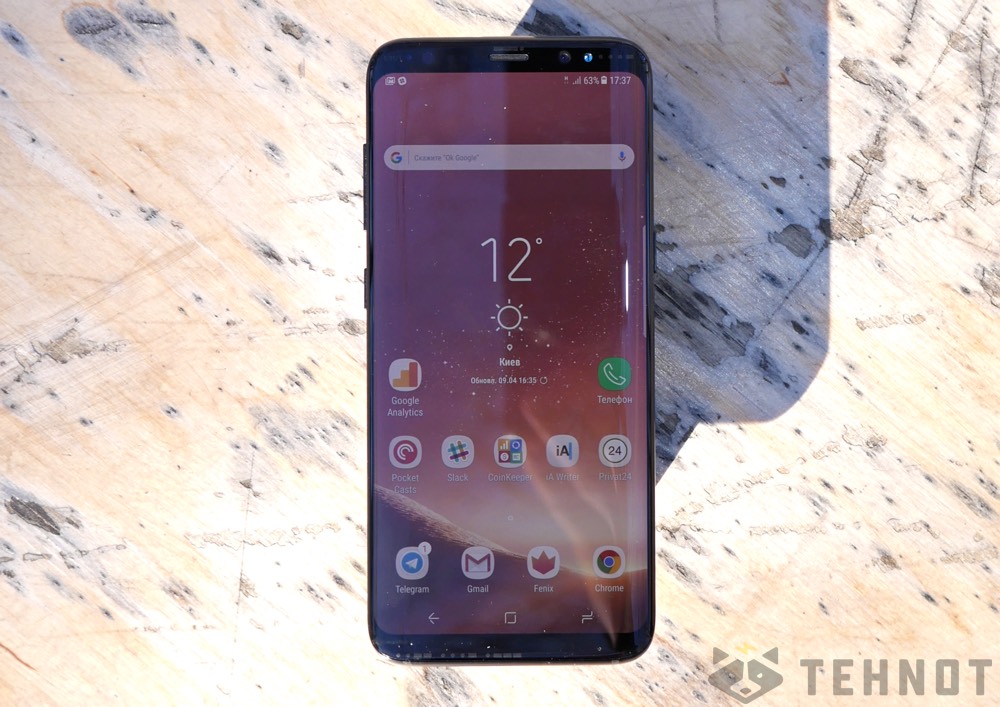
Image quality is top notch: the picture is clear and juicy, blacks are as deep as you can imagine, whites are also accurately transmitted. The picture is perceived a little nicer than on the Galaxy S7 edge, although it is possible that this is facilitated by the form factor in which almost the entire front panel is a solid screen.

Color saturation is slightly overstated, but in the settings it can be lowered to the level of good IPS matrices if you want to achieve more natural colors. At the same time, most users are unlikely to have to do this, since the initially embellished reality looks more attractive. It is allowed to correct colors not only according to several standard modes, but also to move the sliders for red, green and blue colors.
Brightness levels are excellent, both at a minimum that almost turns off the backlight, and at a powerful maximum, at which even the strong sun is not able to distort the image. When tilted even at small angles, the screen turns slightly red, and redness is constantly present on the edges, but this is noticeable only on a white background, besides, we had a pre-sale sample.
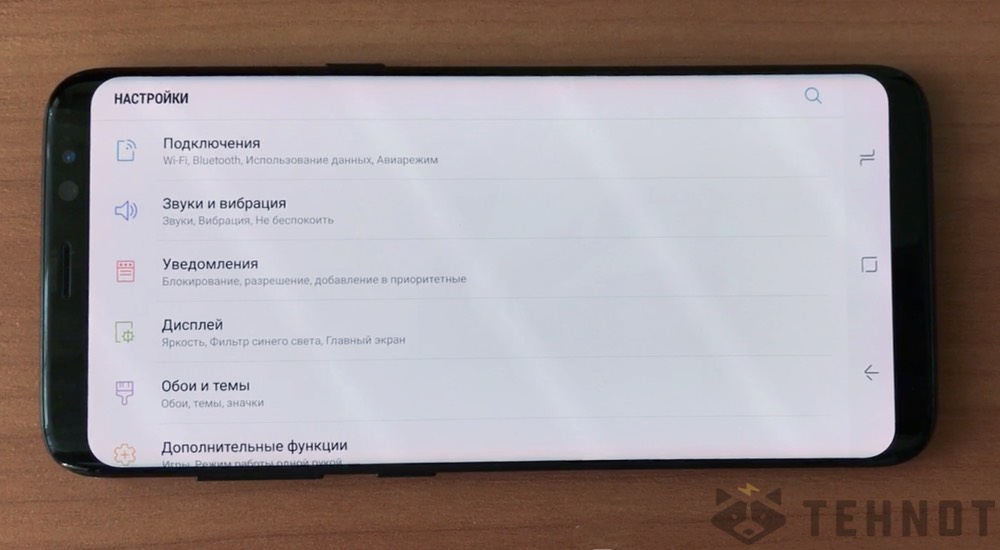
In the final versions of smartphones, the already not very noticeable redness will be even less, if it does not disappear in principle, but when buying, you should still pay attention to this feature and the degree of its manifestation in a particular instance.
New aspect ratio
The new geometry (18.5:9 instead of 16:9) has resulted in many programs appearing with black bars at the top and bottom. However, there is programmatic way stretch them, it is highlighted by an additional menu in "Settings".

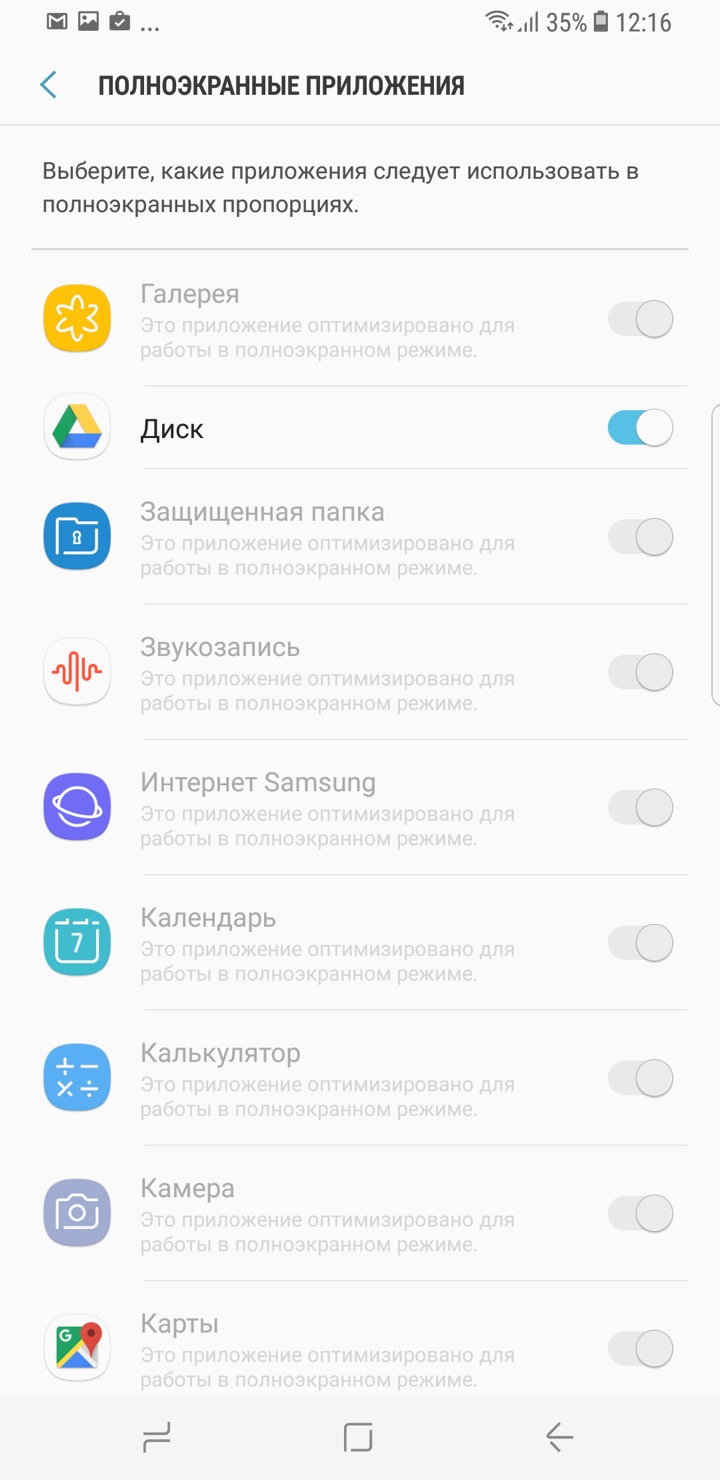

A short test in two dozen programs with graphics and texts, as well as in games, showed stable operation of program stretching. The shell automatically activates it for optimized programs and games (for example, Asphalt 8), but in most cases you will have to go to a separate menu and enable the setting for each application separately. By an incomprehensible reason samsung does not allow you to do this automatically for any software.
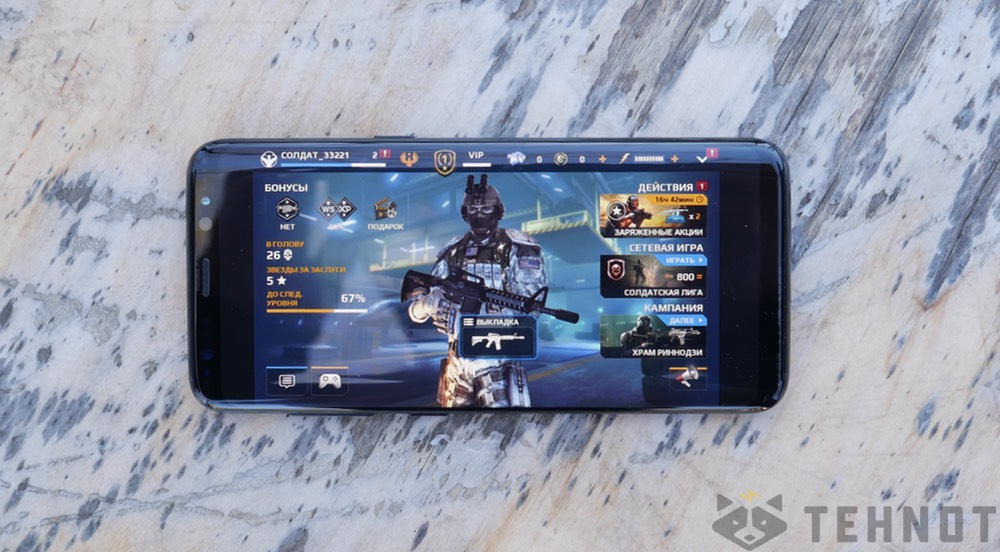
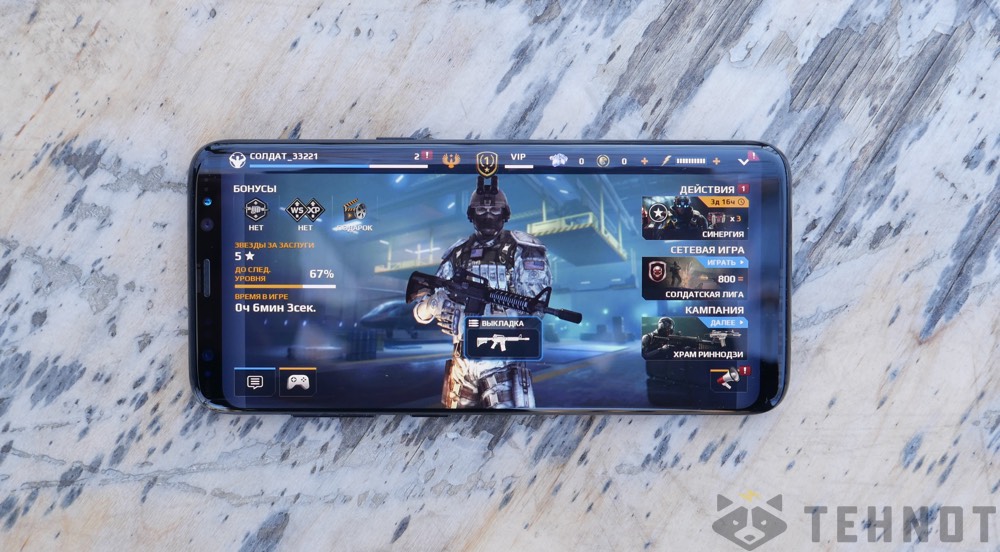
Most programs stretch correctly, this applies to both social networks and instant messengers, and games. I was pleased that not only actual projects with support (Modern Combat 5), but also forgotten ports of classics like grand theft Auto 3. However, in certain games and software with predominantly graphics, you can see how certain elements slightly go beyond the edge of the display - apparently, software stretching scales fixed elements in width and aligns in height.
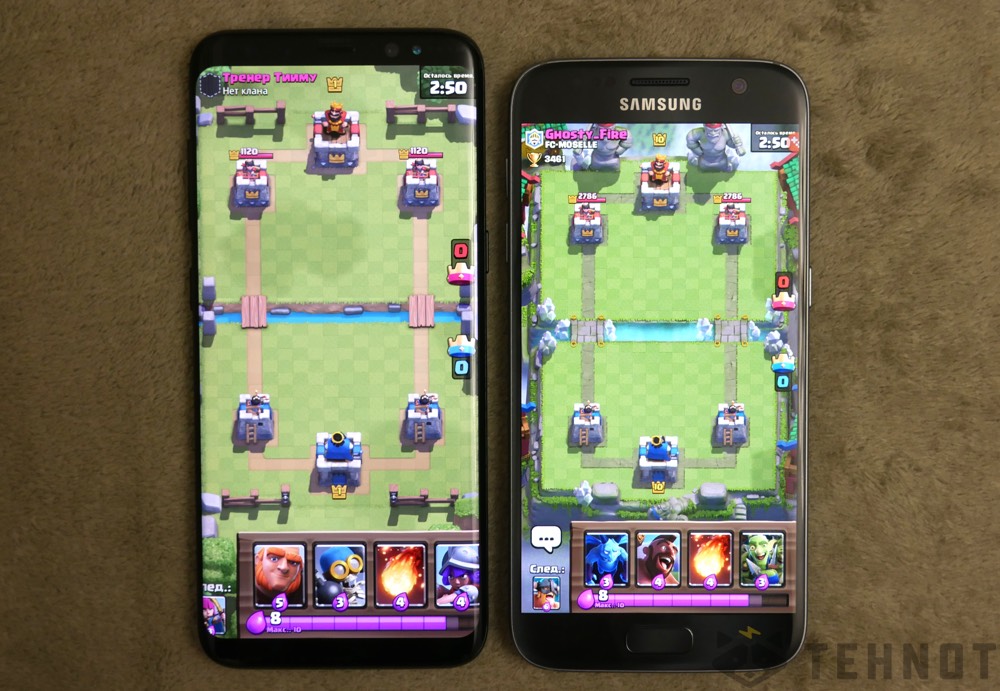
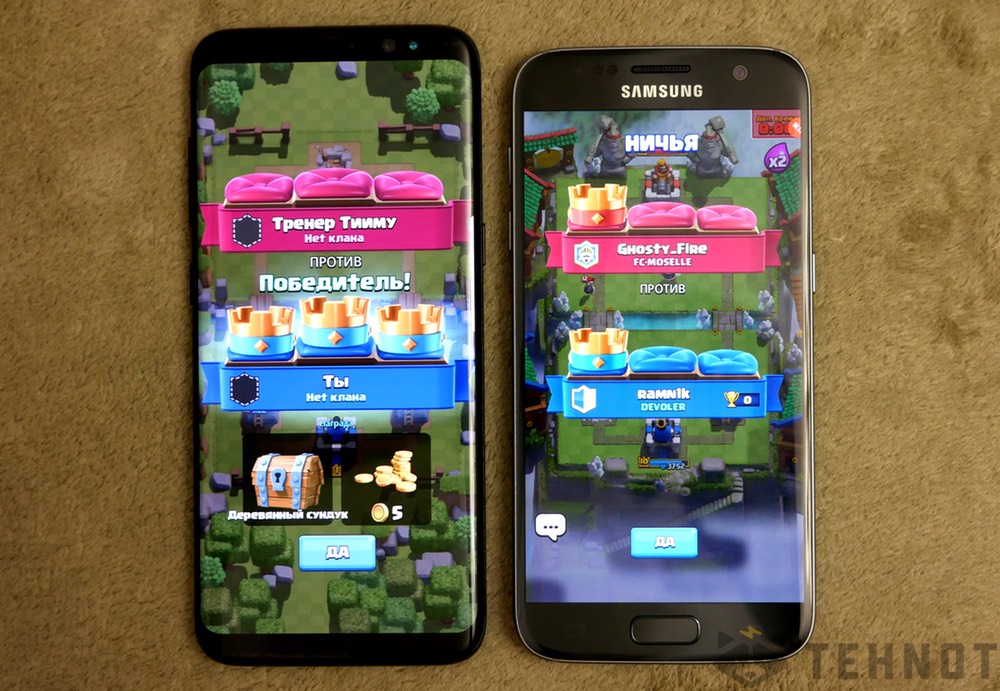
Movies with 21:9 aspect ratio look great:
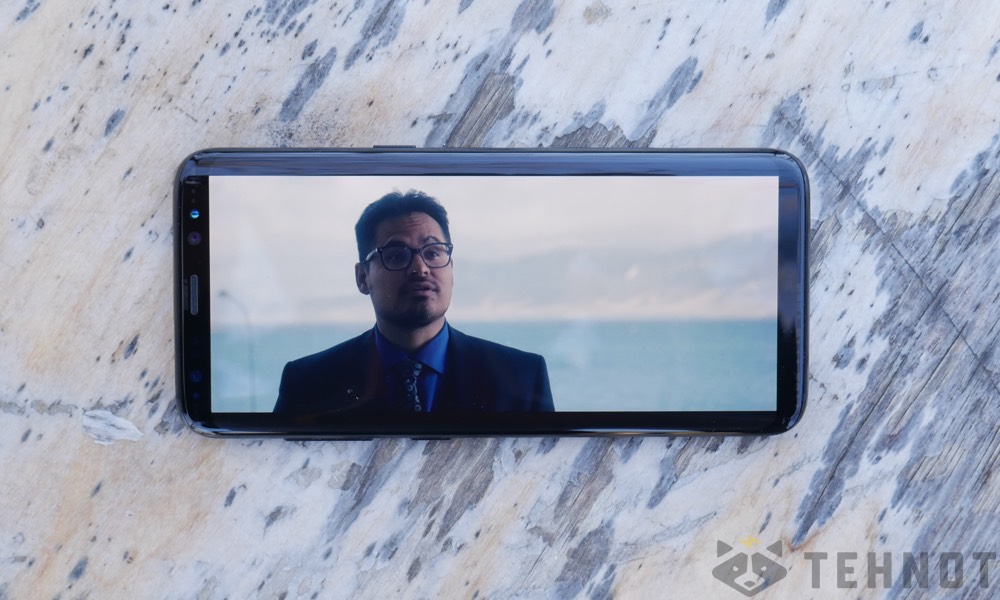
Interestingly, third-party software even in its unfinished form looks great with the new ratio, but the universal clipboard (one of the functions of the curved edge) shows screenshot thumbnails in the wrong ratio and stretches them in width.
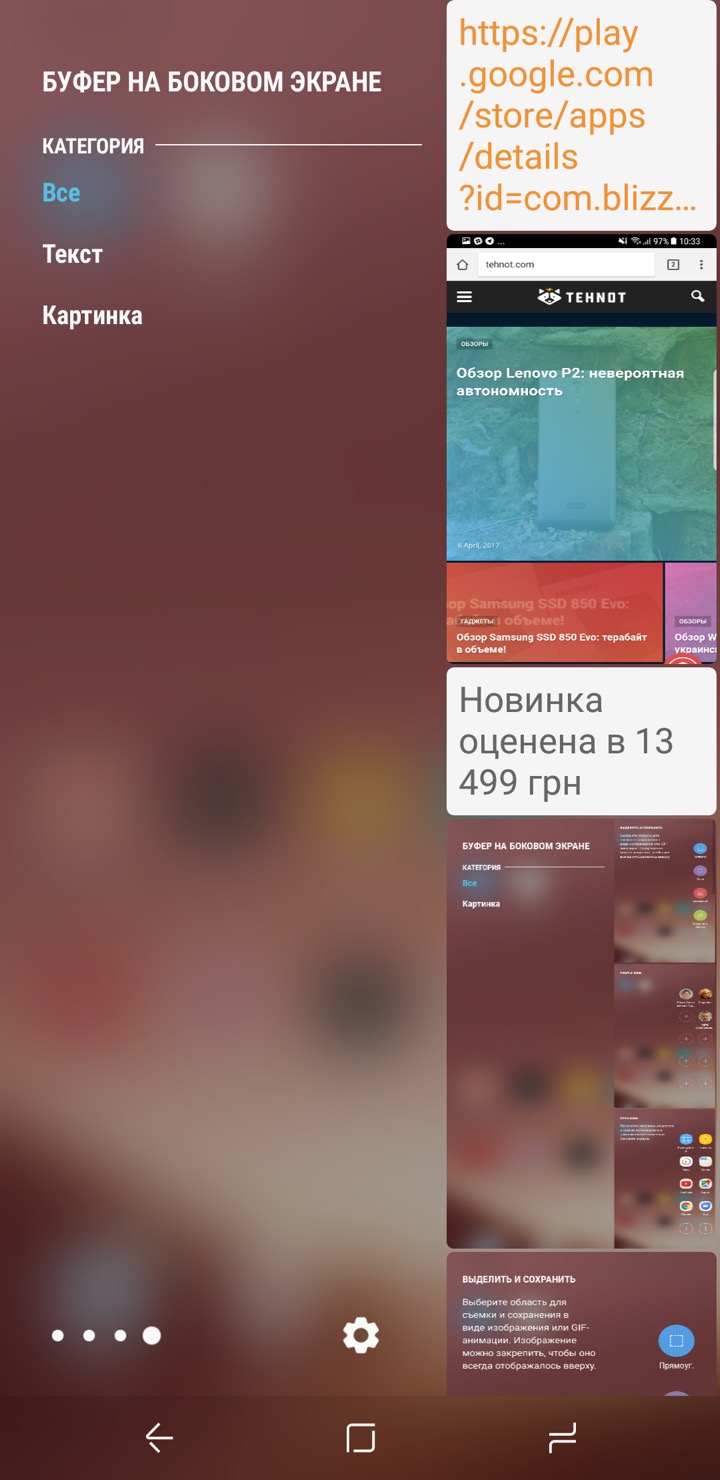
In practice, this does not interfere, because the correct pictures remain in the memory, but it looks strange. Surely, this oversight will be corrected in the next update just in time for the start of sales or in the first weeks after the device enters the market.
Performance
The Samsung Galaxy S8 will go on sale in Ukraine in a version with a proprietary Exynos 8895 processor, which was developed using a 10-nm process technology. In theory, this will provide low heating. At the same time, there is a lot of power in it, as benchmarks say:
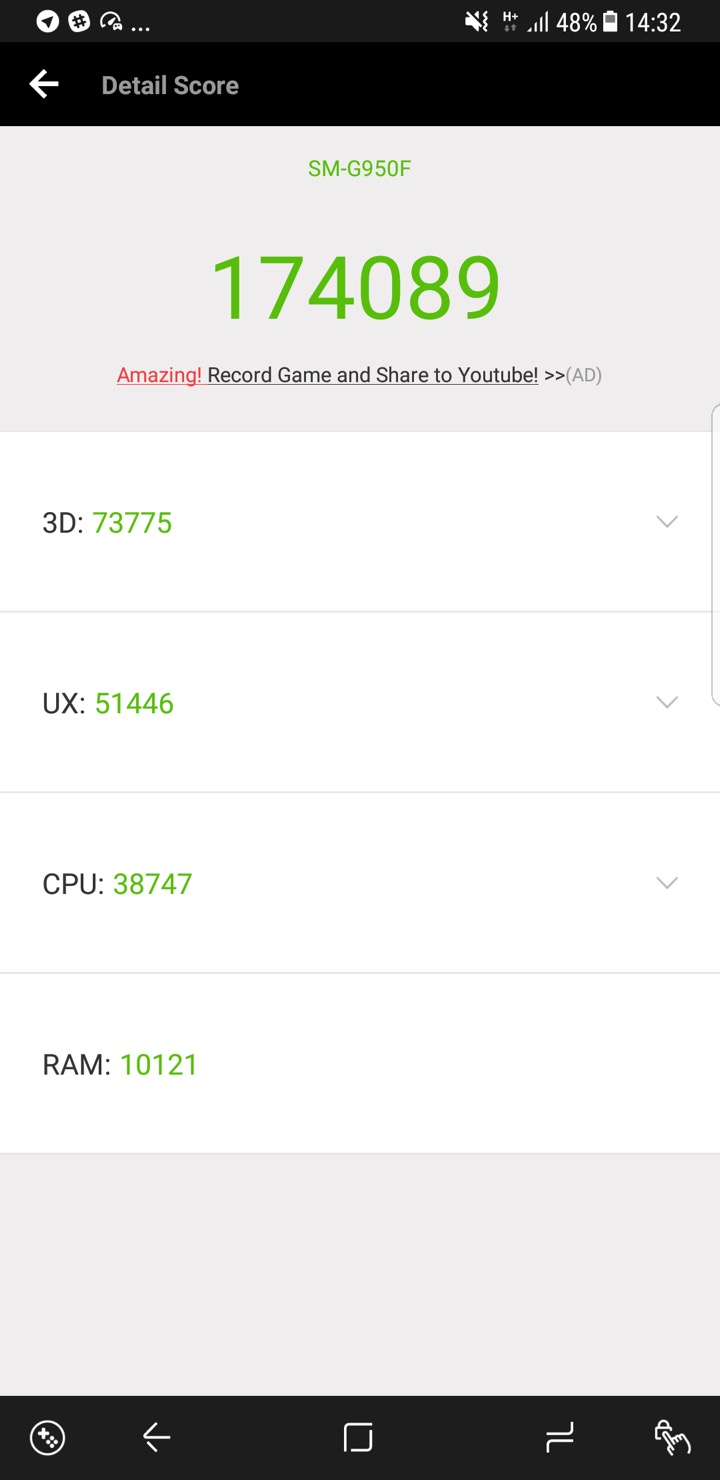
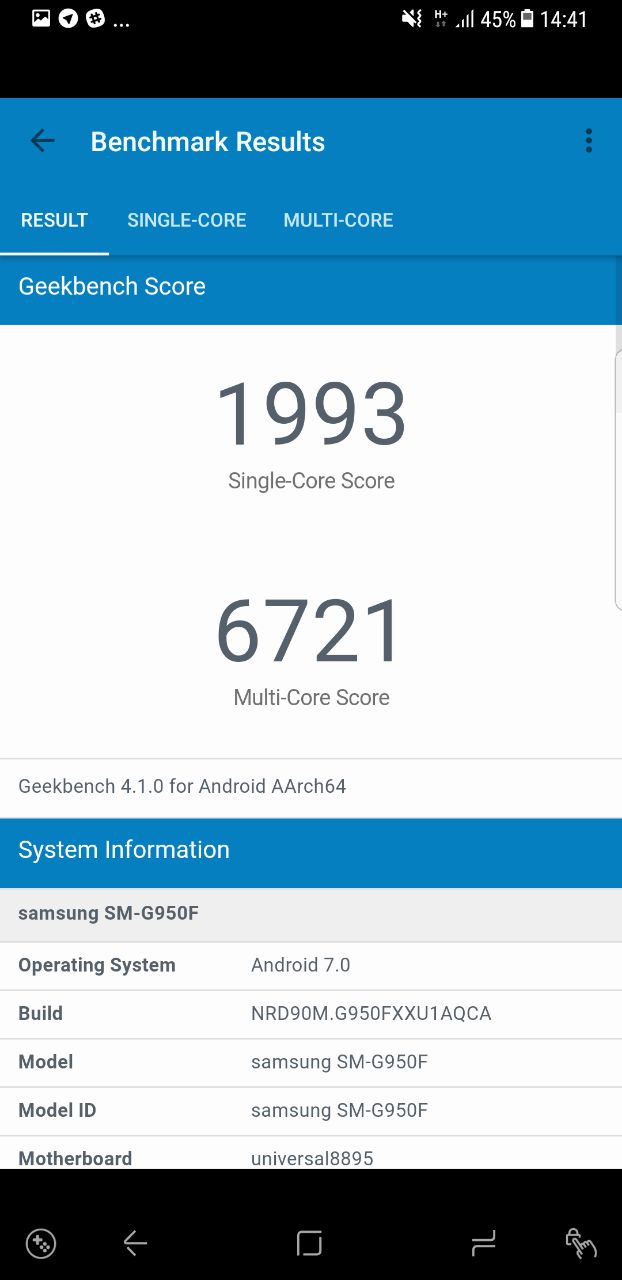
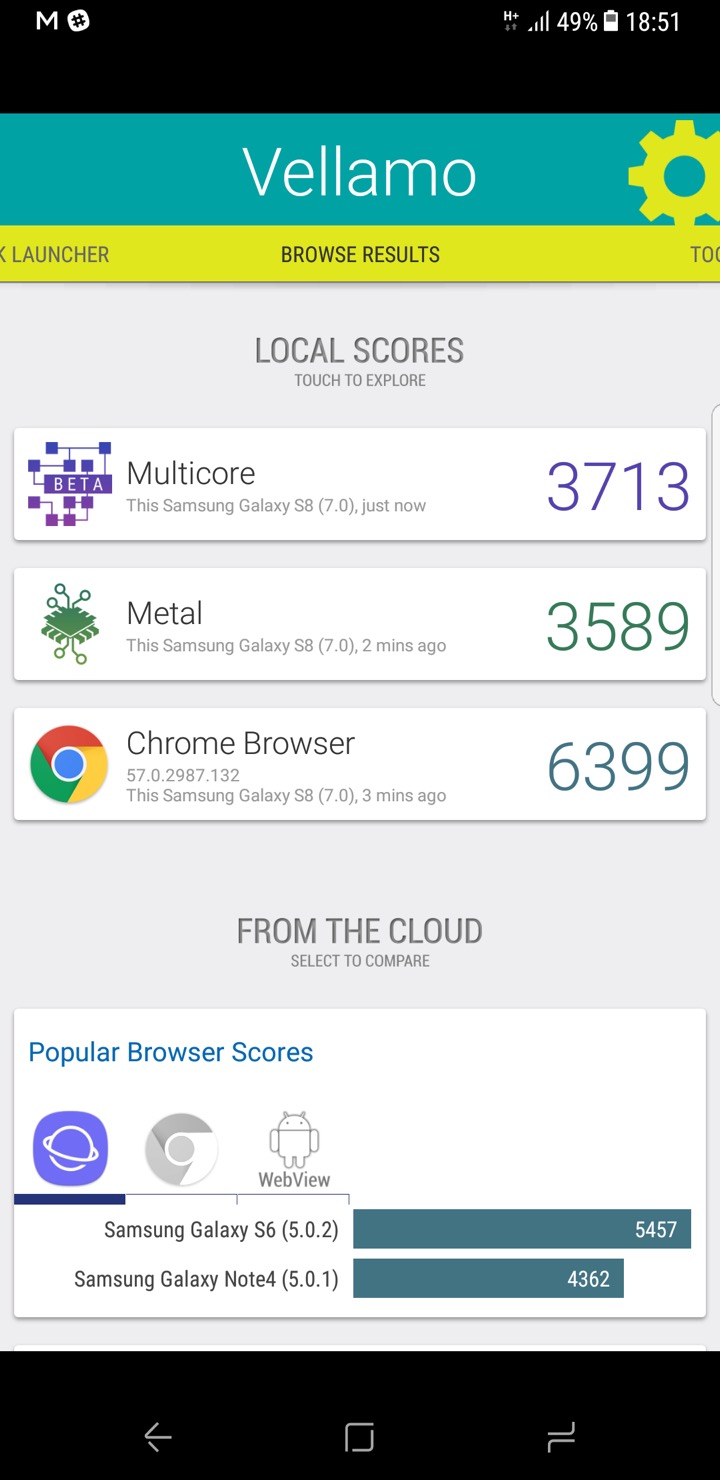
All games run remarkably: smoothly, quickly, with a stable frame rate. The shell is also smooth, as is the application software. Rare slowdowns can be found only in two cases: during the initial setup of the device and the active installation of three dozen programs (all smartphones slow down under these conditions), as well as when swiping on a non-zero screen where Bixby lives. And if the user encounters the first one only once, the second condition is likely to be resolved in the future, when Bixby will constantly work in the background, as it happens with Google Now.
The device works equally smoothly both at full display resolution and in Full HD mode, which is active by default. The difference in the speed of work, if present, is not noticeable at all.
Excellent performance is to be expected from a top-end device, but Samsung was able to surprise us in terms of heating as well. Network battles for 40 minutes practically do not heat up the device, it becomes barely warm. Only radio modules managed to warm up the case on a long trip, where communication constantly appeared and disappeared, however, even in such a situation it was not necessary to intercept the device. Low heating ensured stable autonomy under almost any load.
autonomy
The Samsung Galaxy S8 received a 3000 mAh battery, which provides autonomy typical for most flagships - about 5 hours of active display with 20 hours of standby time. The workloads, as befits a typical device, were high: 30 minutes of YouTube video, 20 minutes of 3D games, two social network clients and three instant messengers with constant correspondence and many push notifications, four mailboxes, two dozen other useful programs.
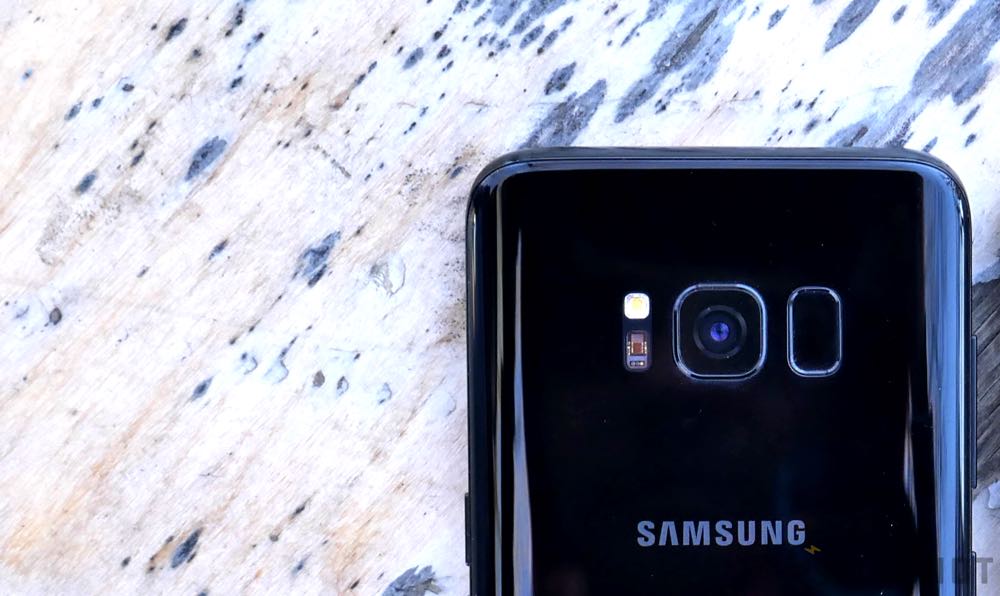
True, unlike almost all competitors, such indicators are achieved with the active mode “Always on display”.
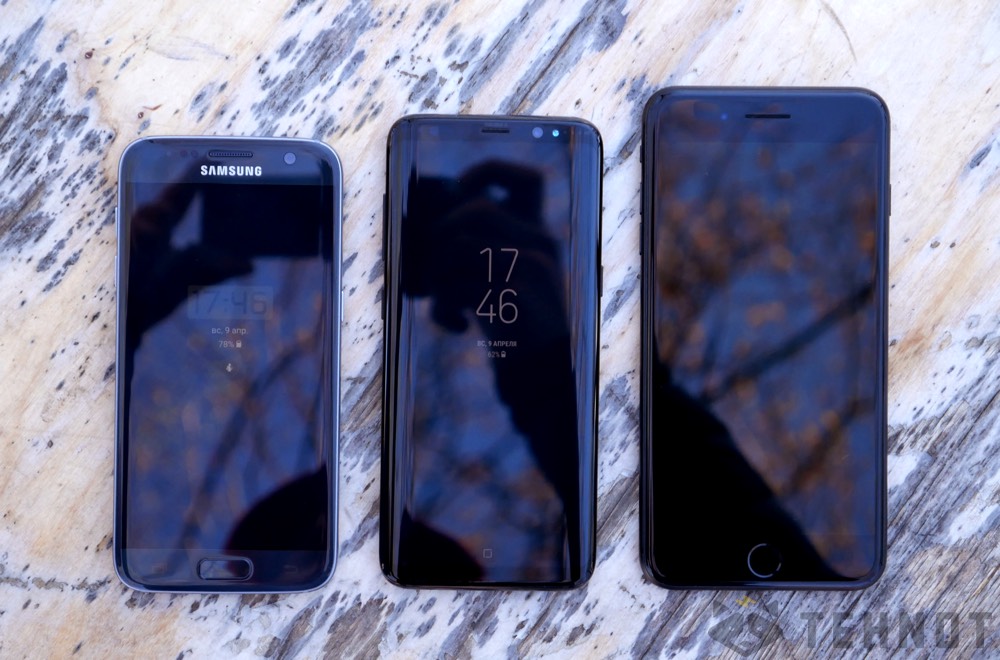
Without it, it usually ends up being 40 minutes more screen time, but what's the point of not using one of the key features flagship?
The display resolution (2220 × 1080 or 2960x1440 pixels) does not affect autonomy much - with the first smartphone, it provided 20-30 minutes more screen work
The device supports fast charging over the wire, in addition, inductive charging is also accelerated: it delivers up to 2.4 A, which is noticeably more than the standard 1.5 A for the Qi standard. This Charger not included, but it, if you pre-order from official sellers.
Since the connector has changed to USB Type-C in the Samsung Galaxy S8, new features have appeared that will be revealed to the maximum with docking station DeX, but some pleasant moments can be seen without it, including when connecting the device to another device, you can choose whether to charge from it or, conversely, give power.
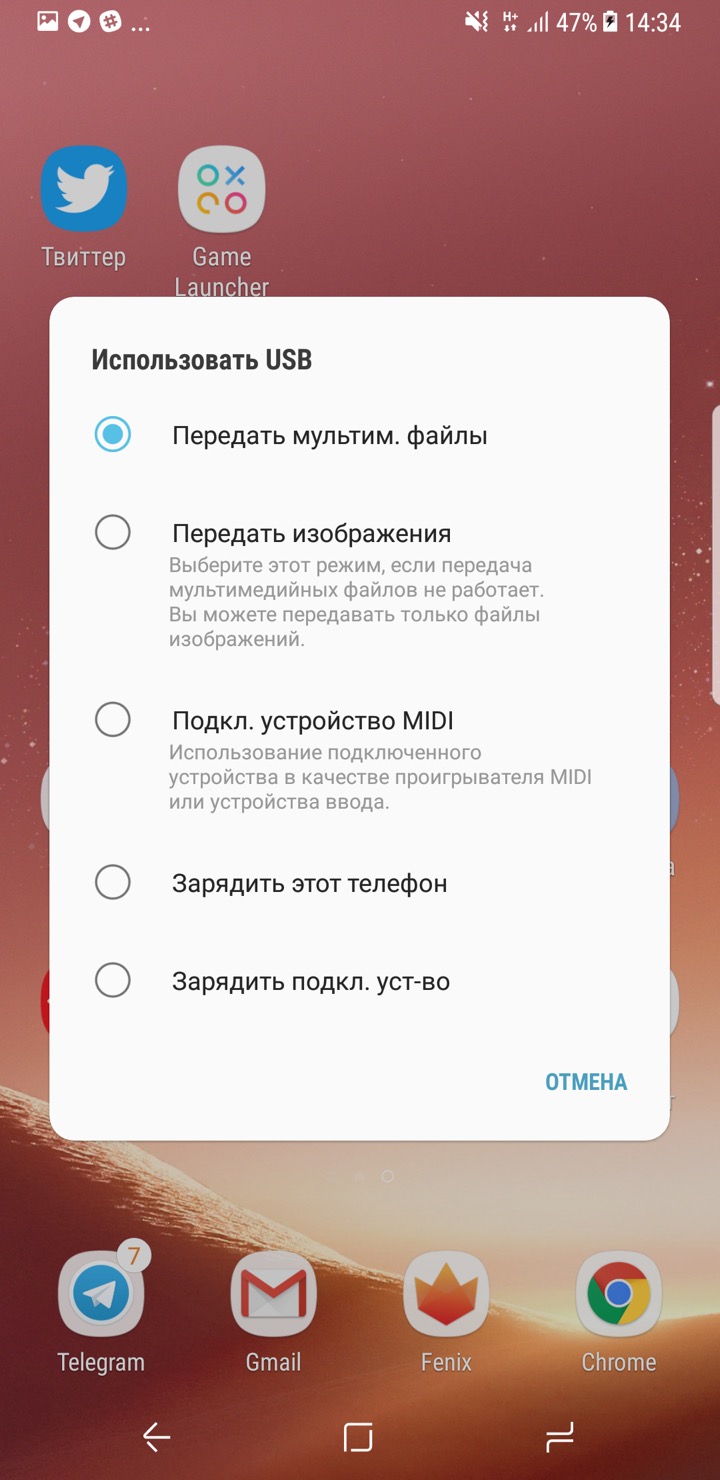
Camera
The Samsung Galaxy S8 received the same main camera as last year's Galaxy S7/S7 edge: 12 MP, f/1.7, lens sandwich. The company said that it has improved the processing algorithms, which usually means "the changes will be almost invisible", but not in the case of the new Samsung flagship.
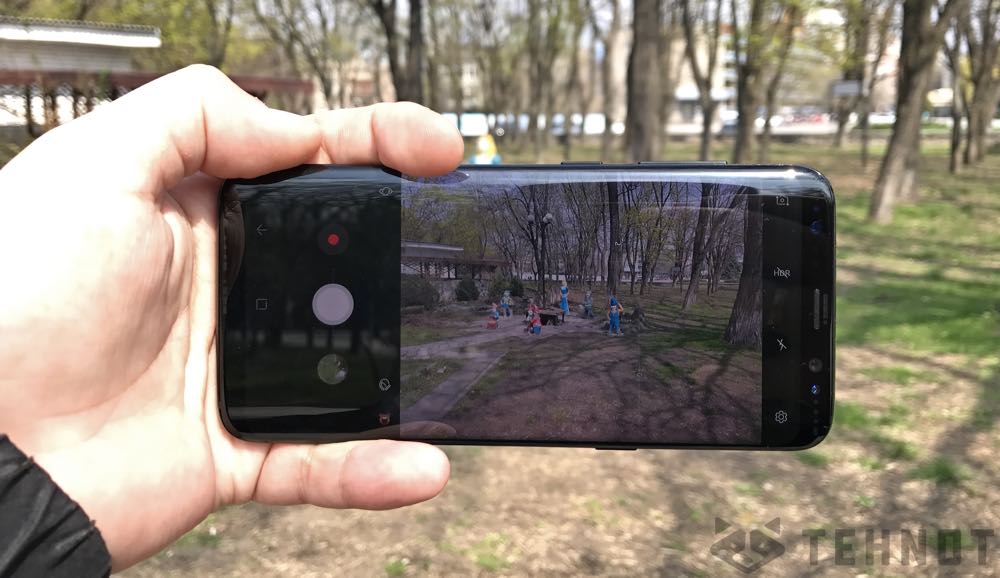
First, about the bad - the algorithms still overestimate the sharpness, which makes it feel like objects at a medium distance have been added to graphics editor, and also makes it a little more difficult to estimate the true distance to the textured object. The device also wiggles white balance on out-of-focus objects, usually making them bluer than they really are.
The mentioned effects are weaker than in cameras of the previous generation, and if color errors are really frustrating, high sharpness has finally become an advantage - paired with an excellent color gamut, the camera manages to show even the smallest details of what is shown in the frame. For example, asphalt relief in landscape shots looks much more like relief than soap streaks, as happens when shooting on the iPhone 7.
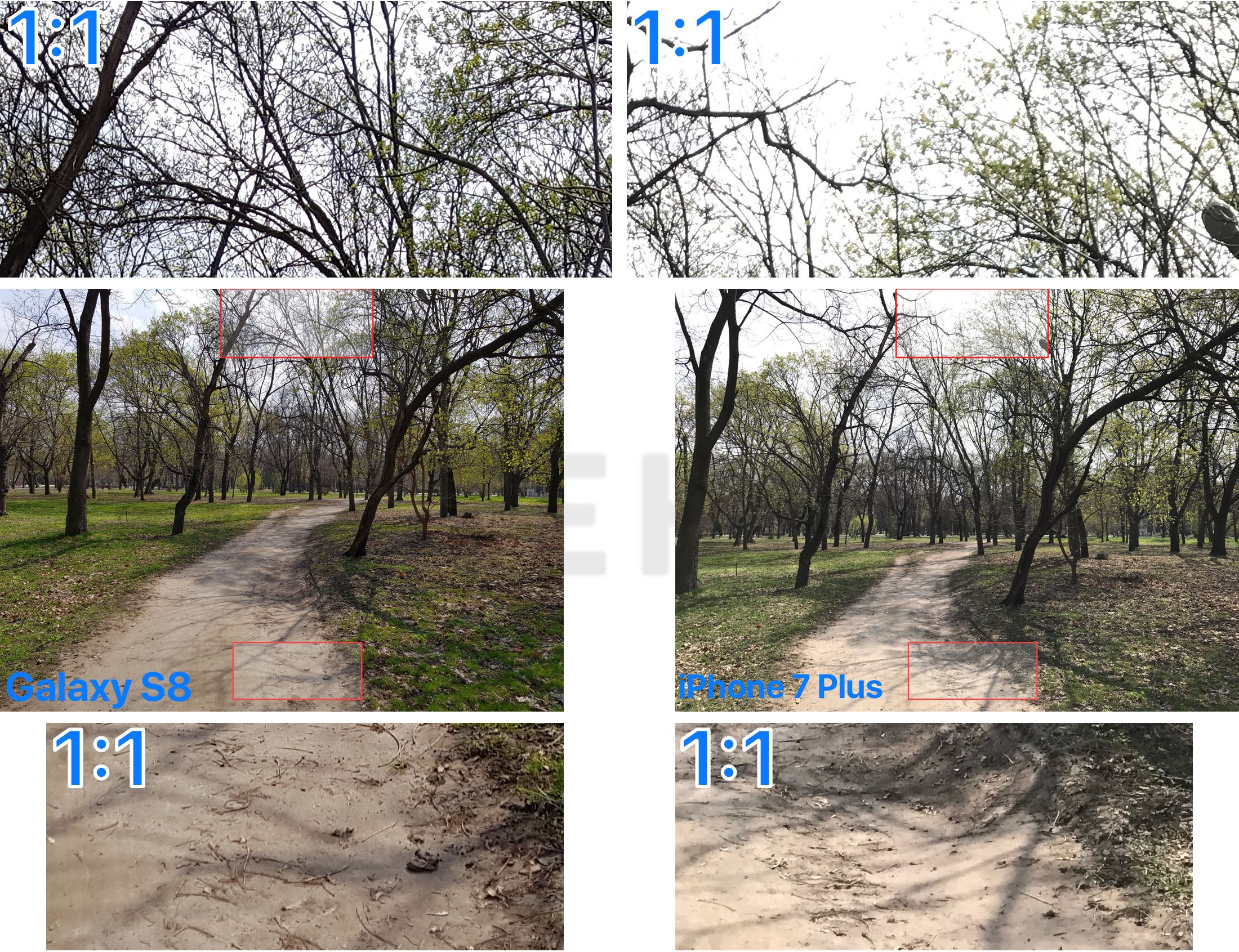
Dark areas, unlike the above-mentioned competitor, do not look like spots or gradient fills - you can almost always see details and texture in them (the algorithm clearly highlights such segments, but within reason). The bright colors in the frame of the Galaxy S8 oversaturate, but these are no longer almost acidic shades, but just a slightly embellished reality. Even the past less natural result appealed to consumers, and the current calm implementation will attract even more people.
1 of 29
Various shooting modes include and set manual settings, which, coupled with the ability to save photos in RAW, will attract an advanced audience. HDR also works great, which will be appreciated by those who dream of the “make beautiful” button, but the last two generations of Samsung flagships also work in this mode. Video recording in Full HD is excellent, and in 4K there is a slight jelly effect from stabilization.
1 of 8
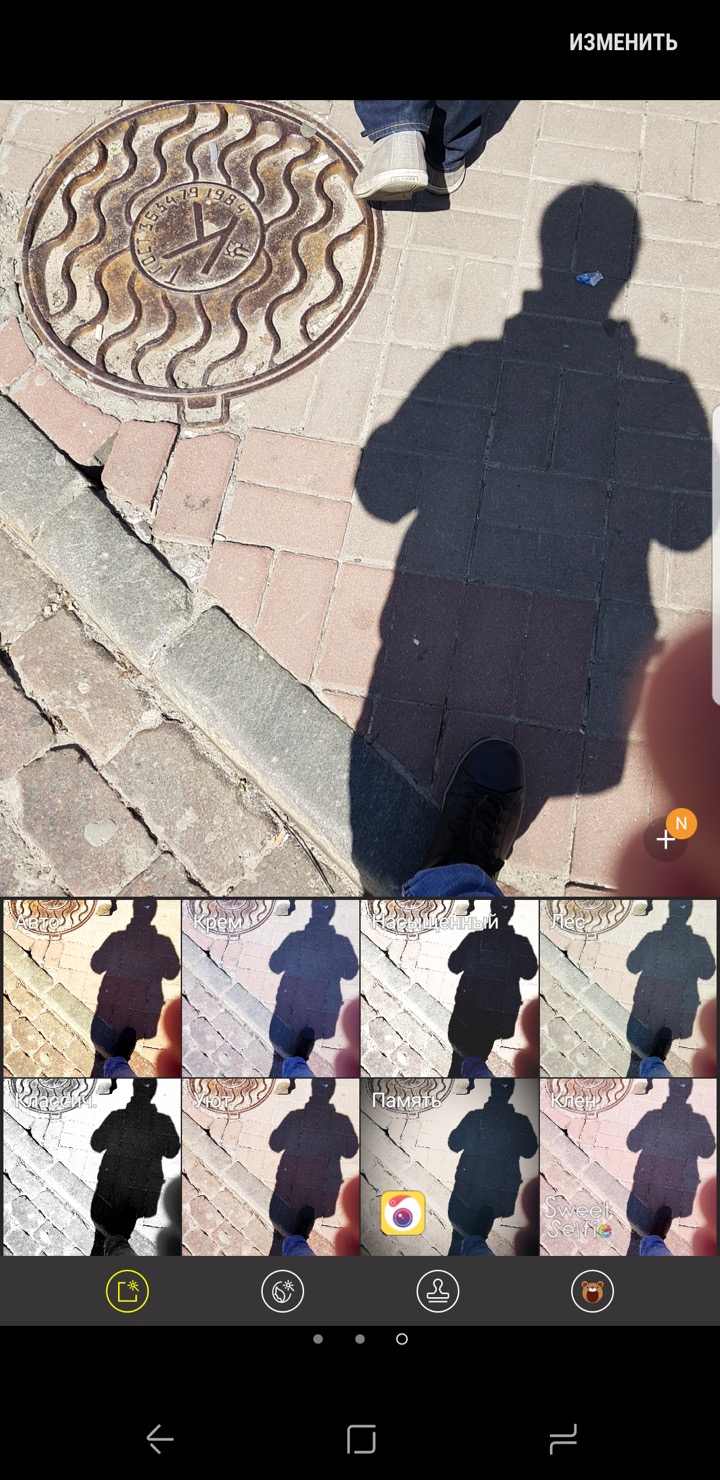
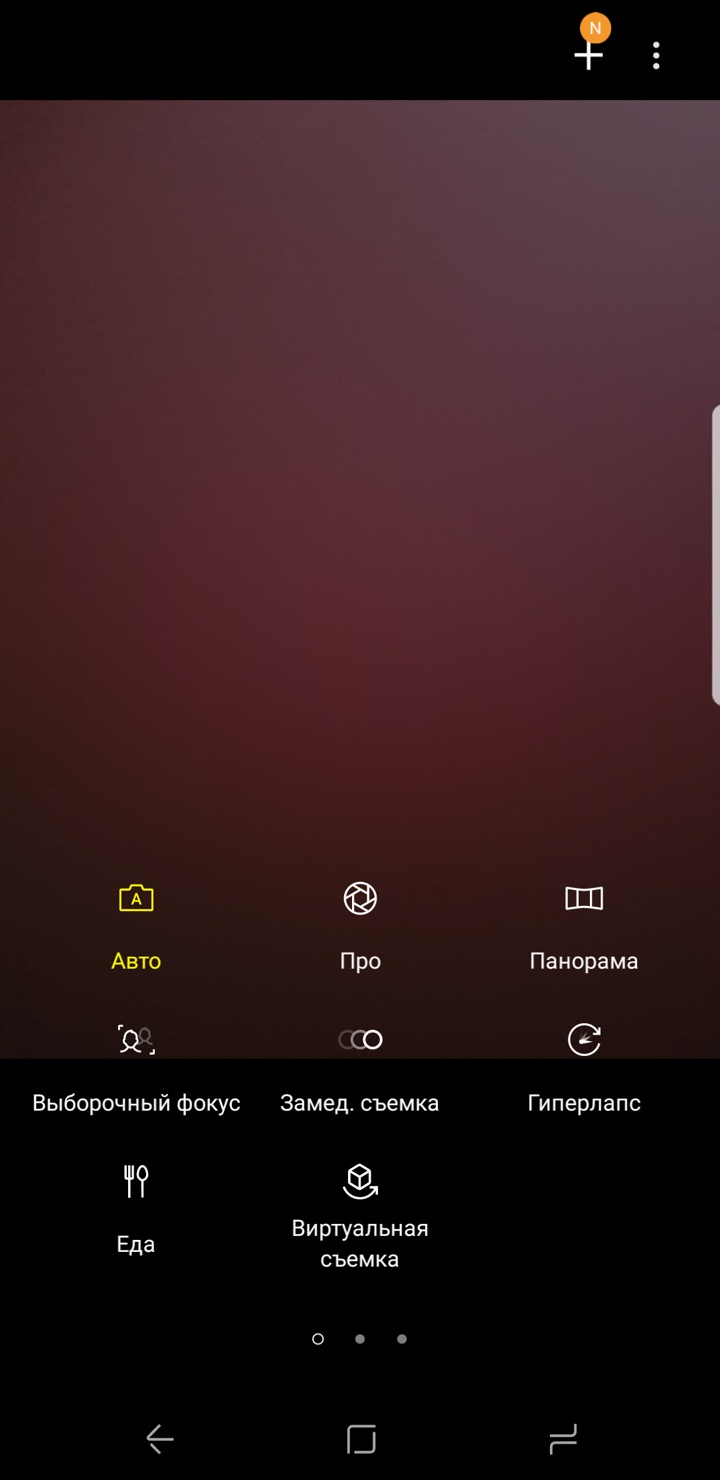
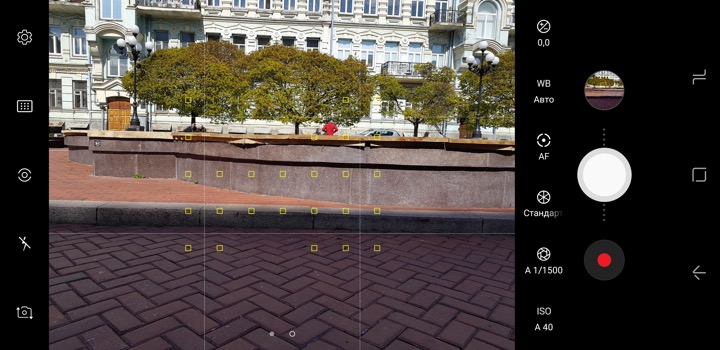
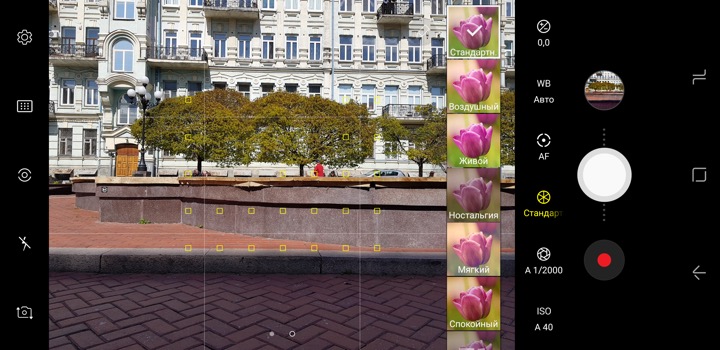
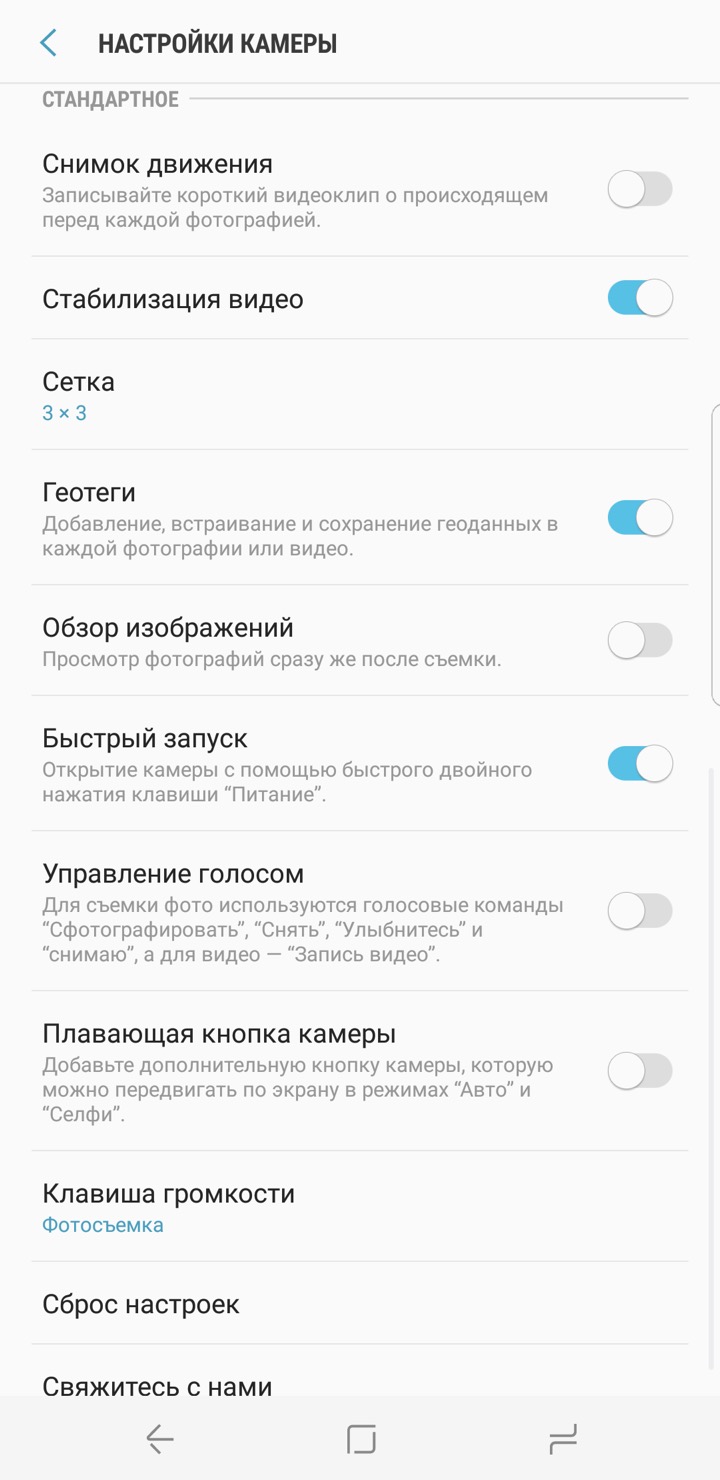

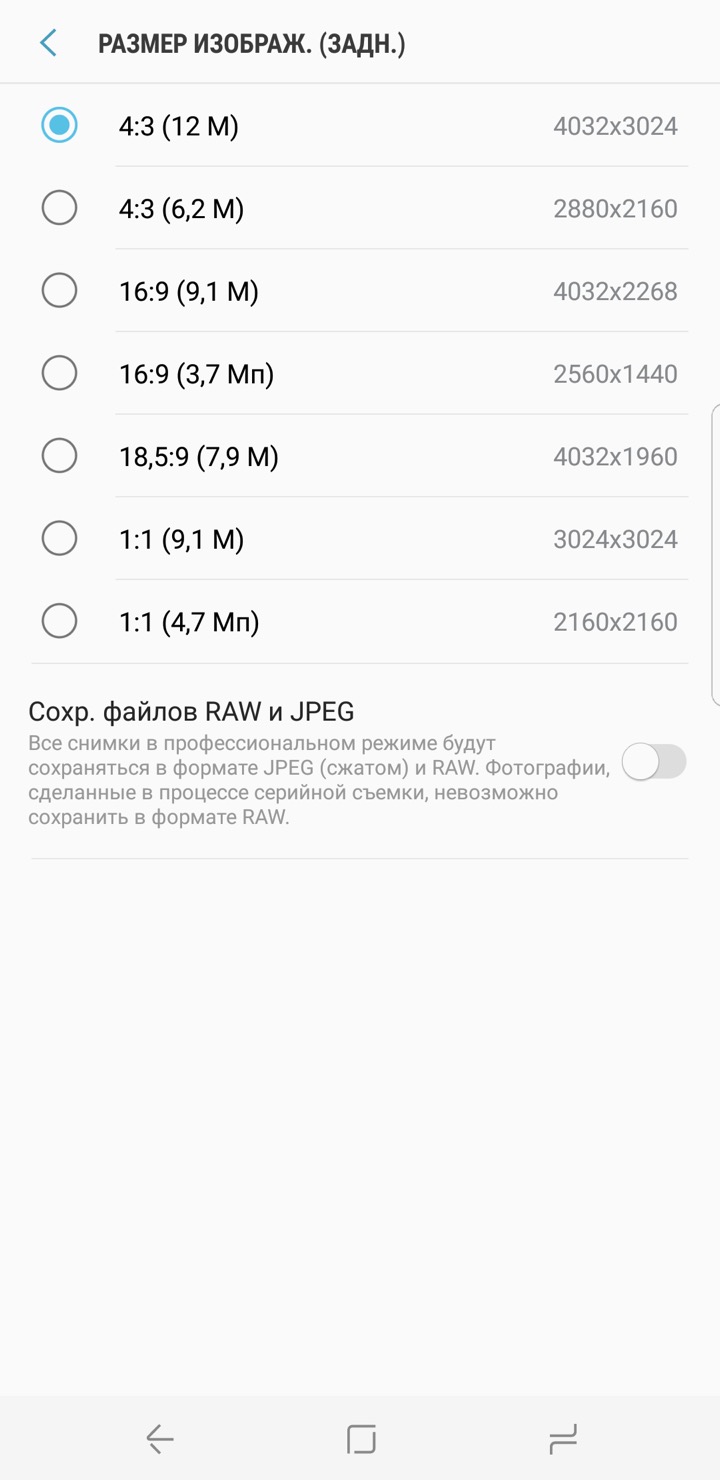
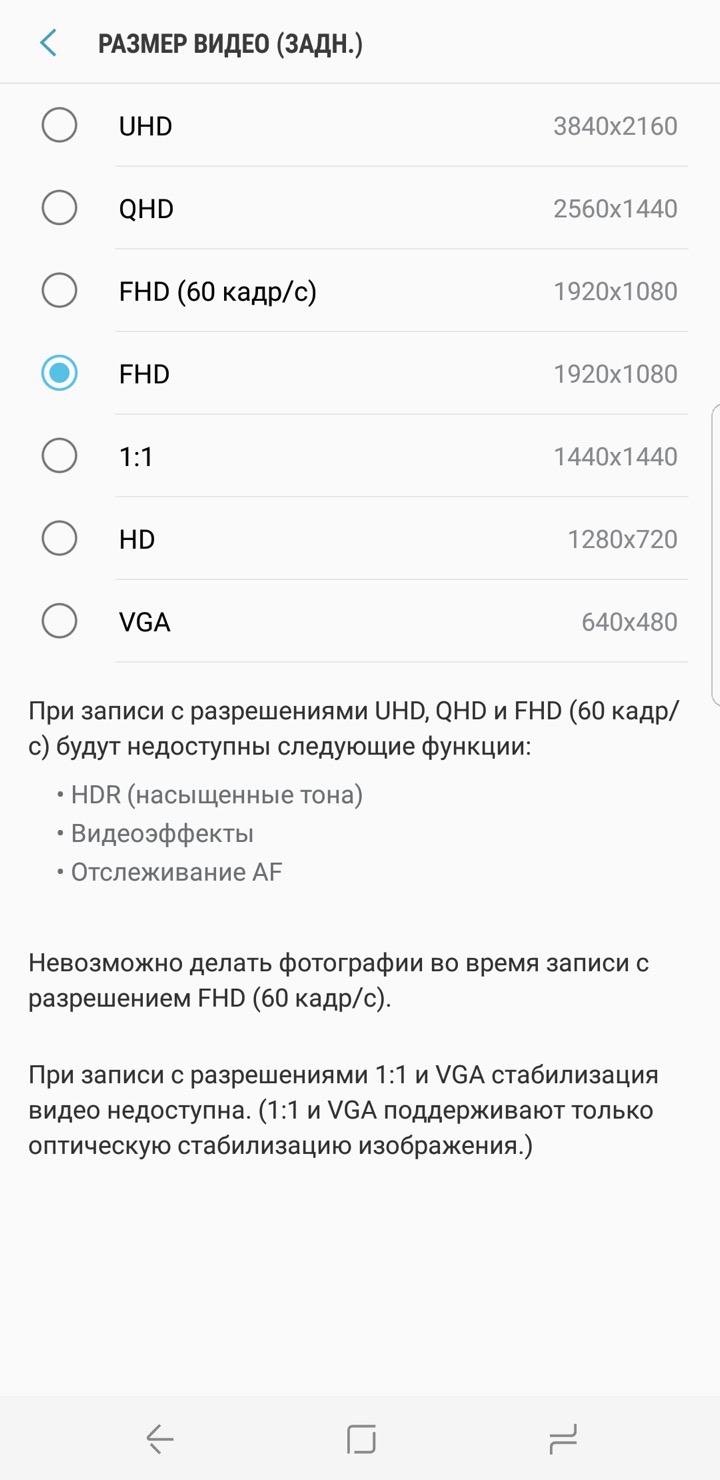
The flagship camera is not a breakthrough compared to the previous generation, but there are many small changes, they all boil down to one thing - to make images more natural. This allows us to call without any reservations Galaxy camera S8 is the best in the smartphone market.
Security and other features
The iris scanner, which Samsung first introduced with the Note7, is also used in the Galaxy S8. The recognition system works well, but there are rare glitches, especially in too bright or too dark conditions, but in 90% of cases it recognizes the owner.

This unlocking method is twice as slow as a fingerprint scanner, and it is also more demanding on conditions - in addition to lighting, the phone must be placed at the correct distance from the face (25-35 cm). But from the outside, such an unlock looks like magic.
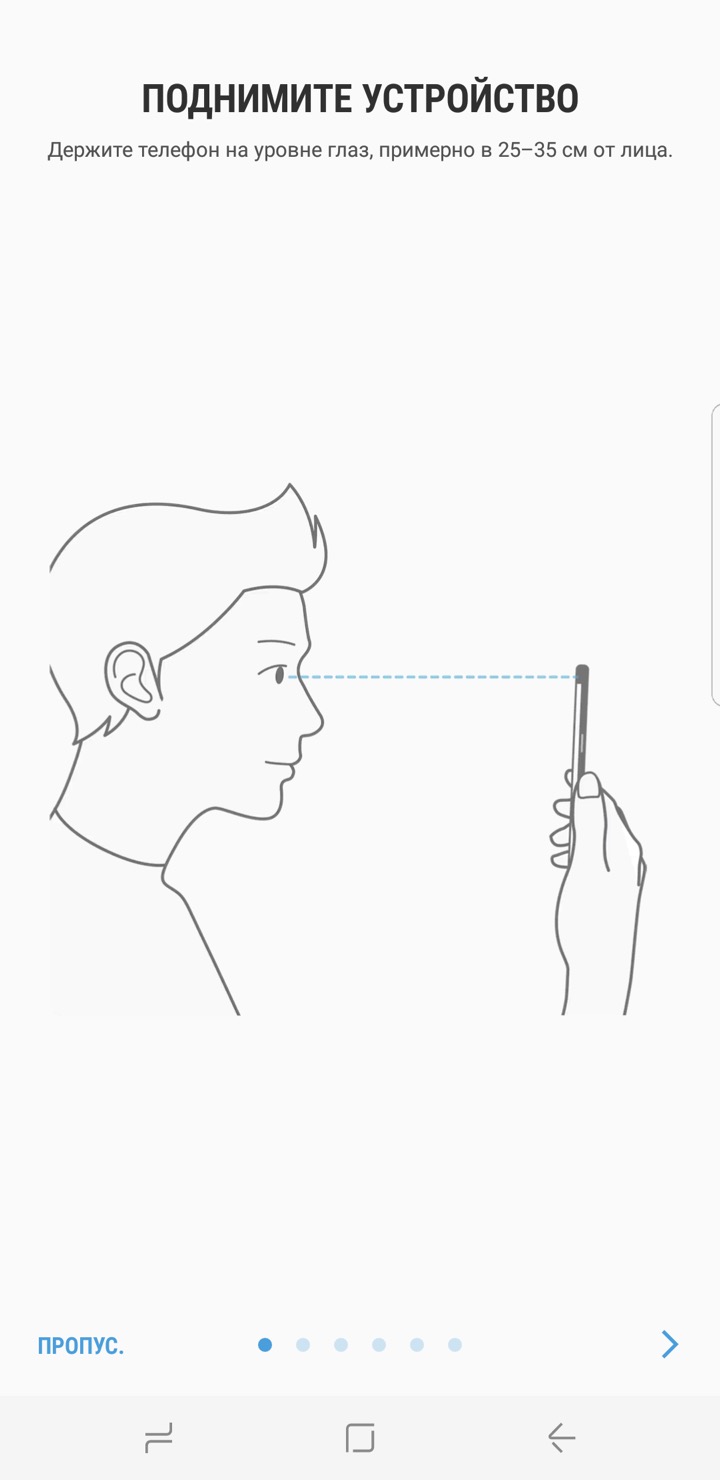


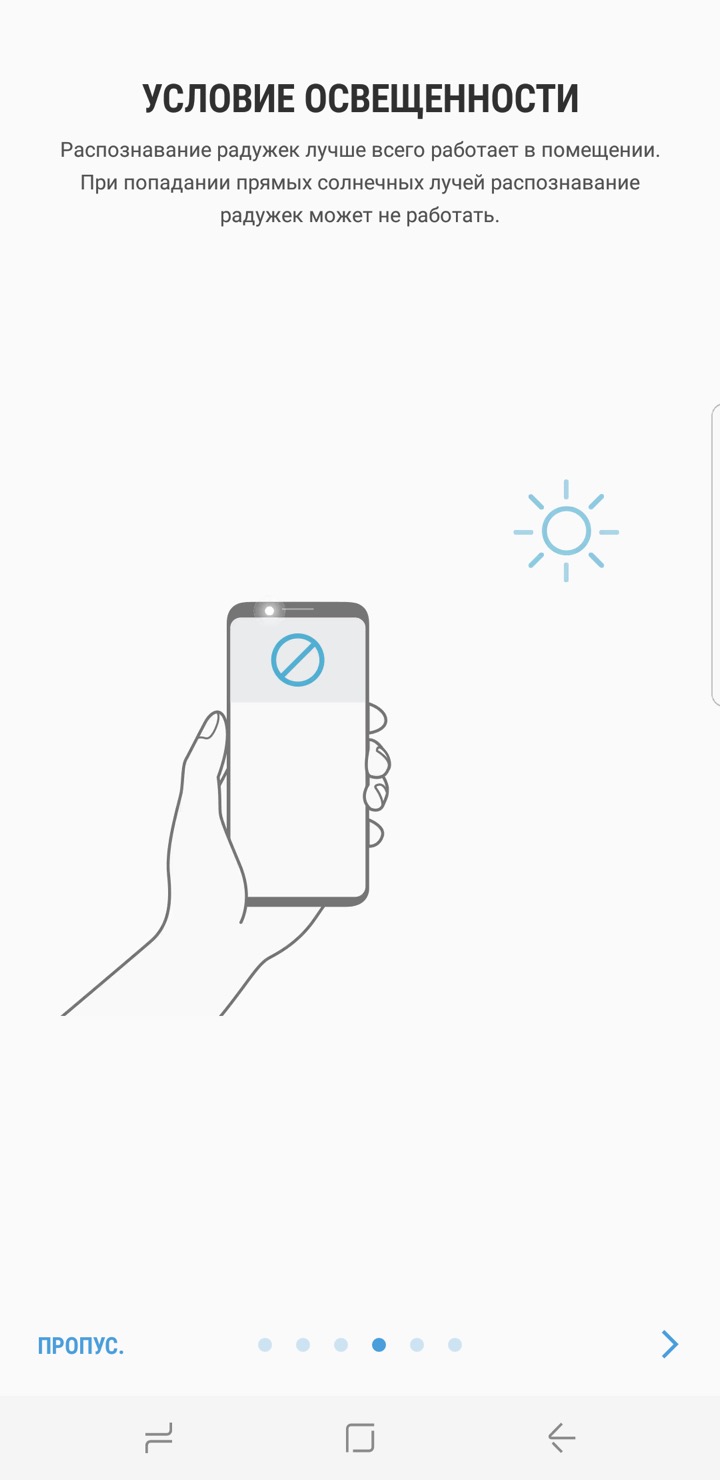
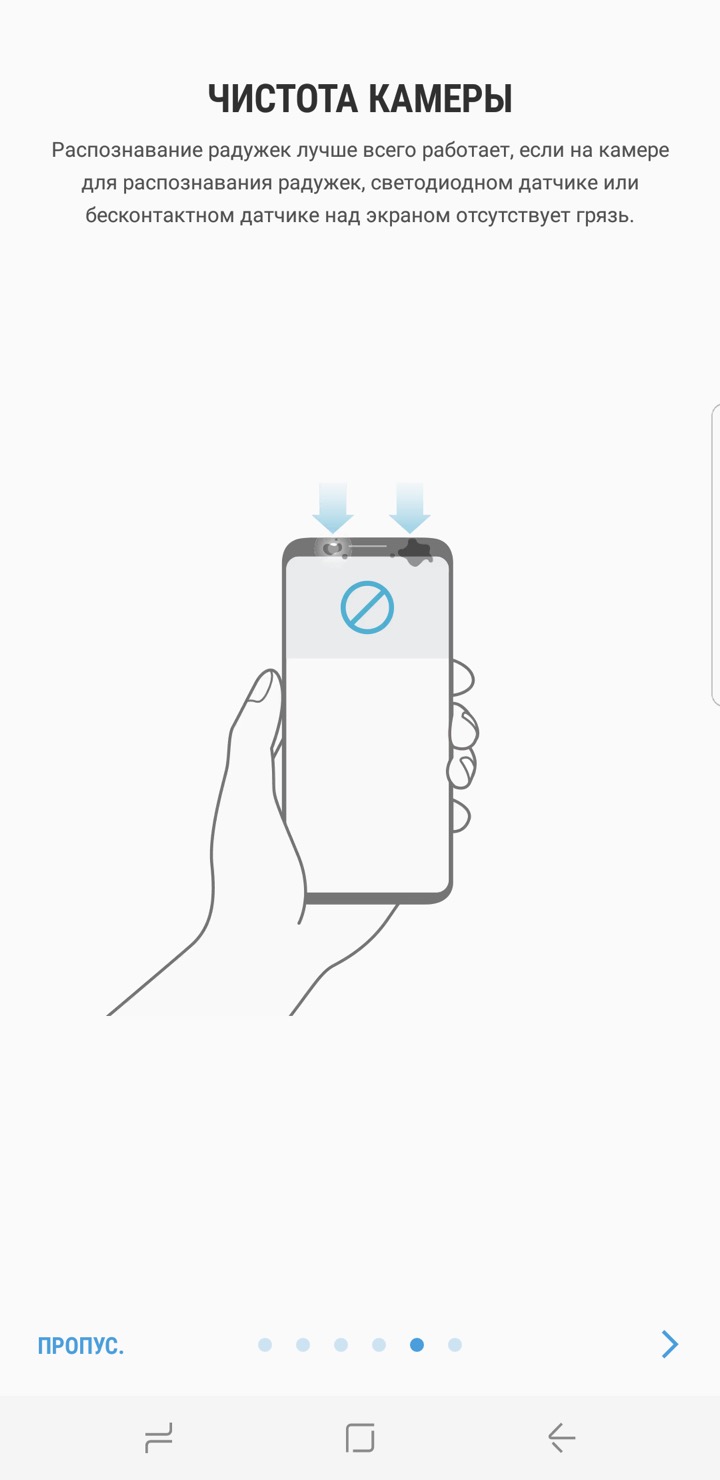

The only real inconvenience of the iris scanner is that the smartphone checks the eyes either after a swipe on the display, or as soon as the screen is highlighted, which is why you don’t always have time to read the notifications on the lock screen. You have to deliberately tilt the device away from your face and look at the display at an oblique angle, or choose a setting that requires more action.
However, in most cases, this method is still more convenient than a fingerprint scanner - the latter is located next to the camera and its frame does not differ from the camera rim, which makes it difficult to understand by touch whether it touched the lens or the desired sensor. In addition, the scanner is located high and not in the center, so it (for people with medium-sized palms) is difficult to get when holding the device in the right hand.
Fingerprint scanner also received new opportunity- When the screen is active, you can swipe up or down on it to close or open the notification shade. The rest of the features, for the most part, are familiar from other Samsung smartphones:

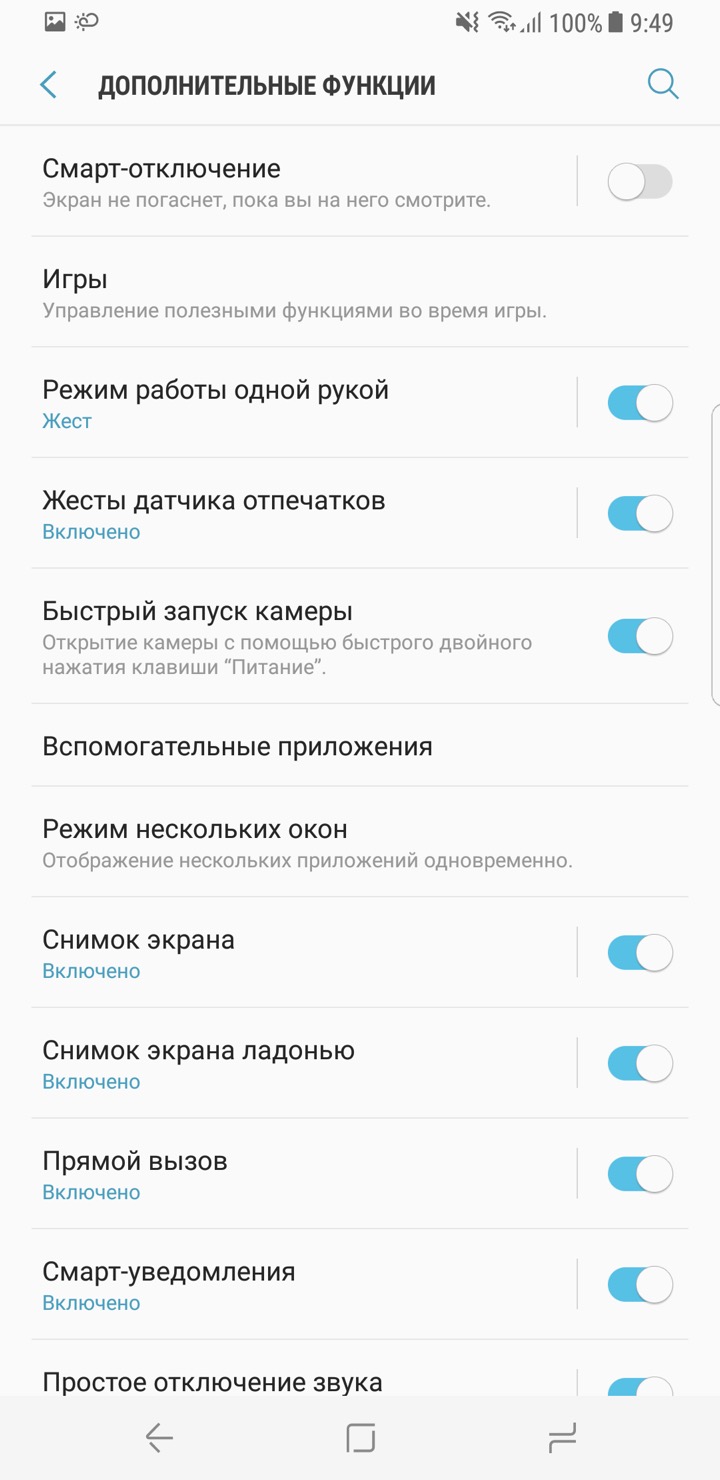


![]()
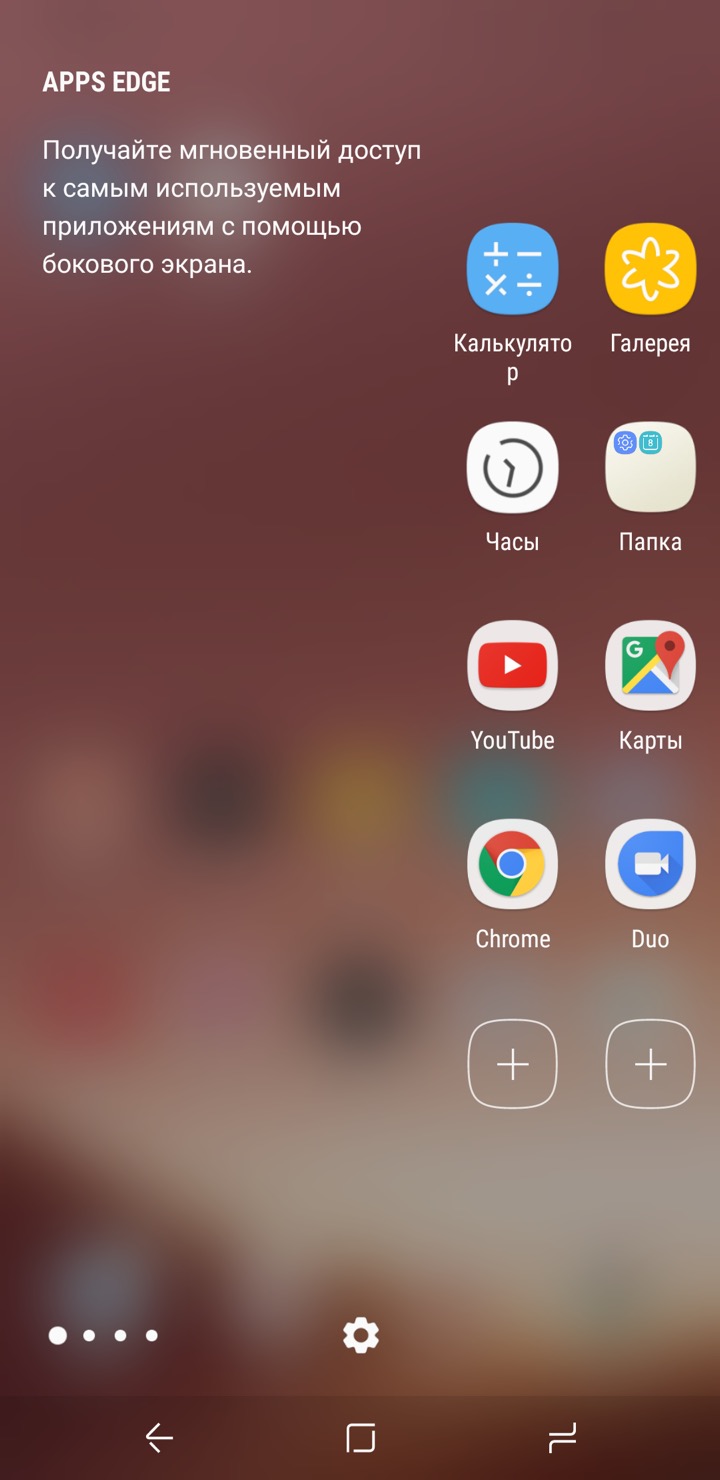
You can not miss and protection against moisture and dust according to the IP68 standard, as well as support for memory cards that are installed in the second slot for SIM-cards. Samsung also added face unlock, but this feature is nothing new - back in Android 4.0 there was such a feature.
Additional features, shell, sound
Samsung Galaxy S8 comes with Android 7.0 Nougat and proprietary shell Samsung experience. The interface has become even calmer, and in general the image is more and more like Android in the Google view: even the “All applications” button has been eliminated, now the list is called up by swiping up or down the center of the display (almost like in Google Pixel).
OS navigation buttons can be swapped - finally, a Samsung smartphone can retain the logic that Google and most other Android smartphone manufacturers adhere to. The button background is also customizable: the user can change its color, but choose transparent background will not work.
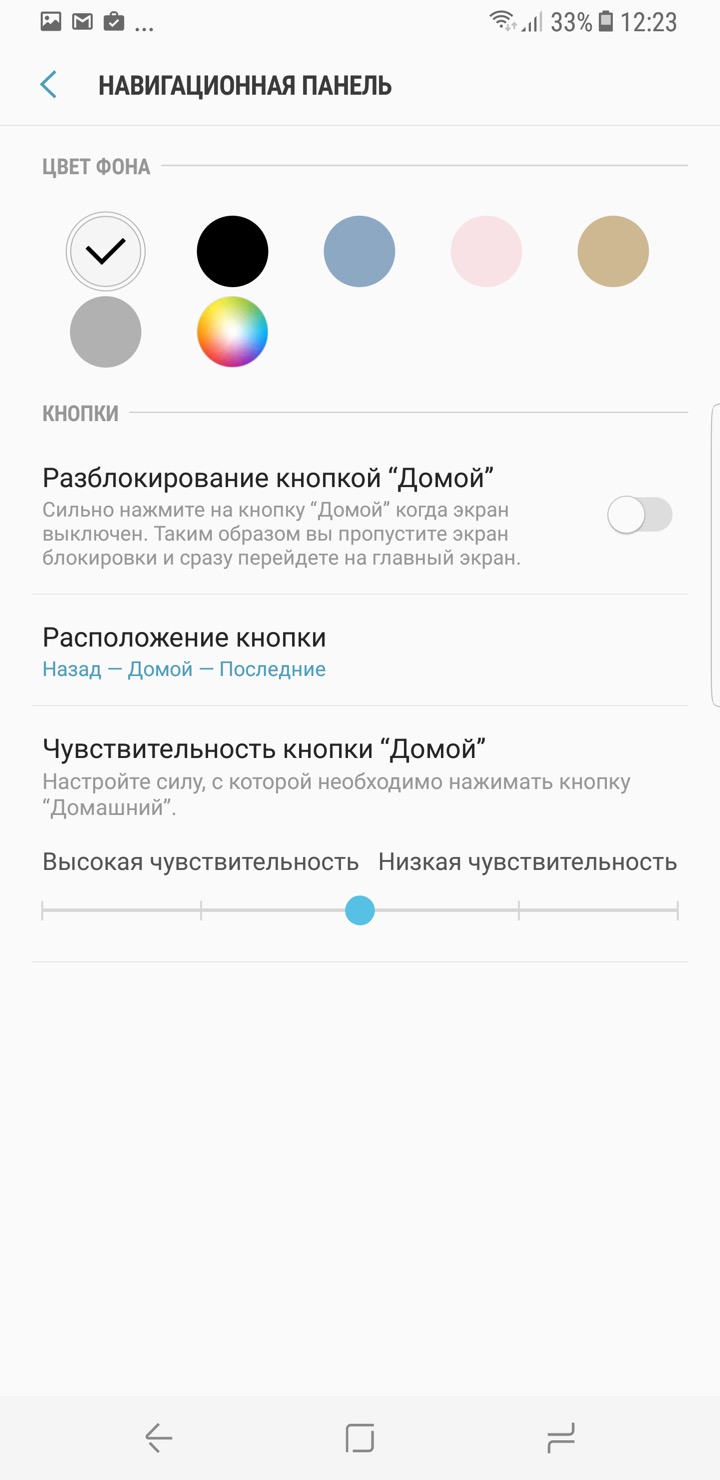
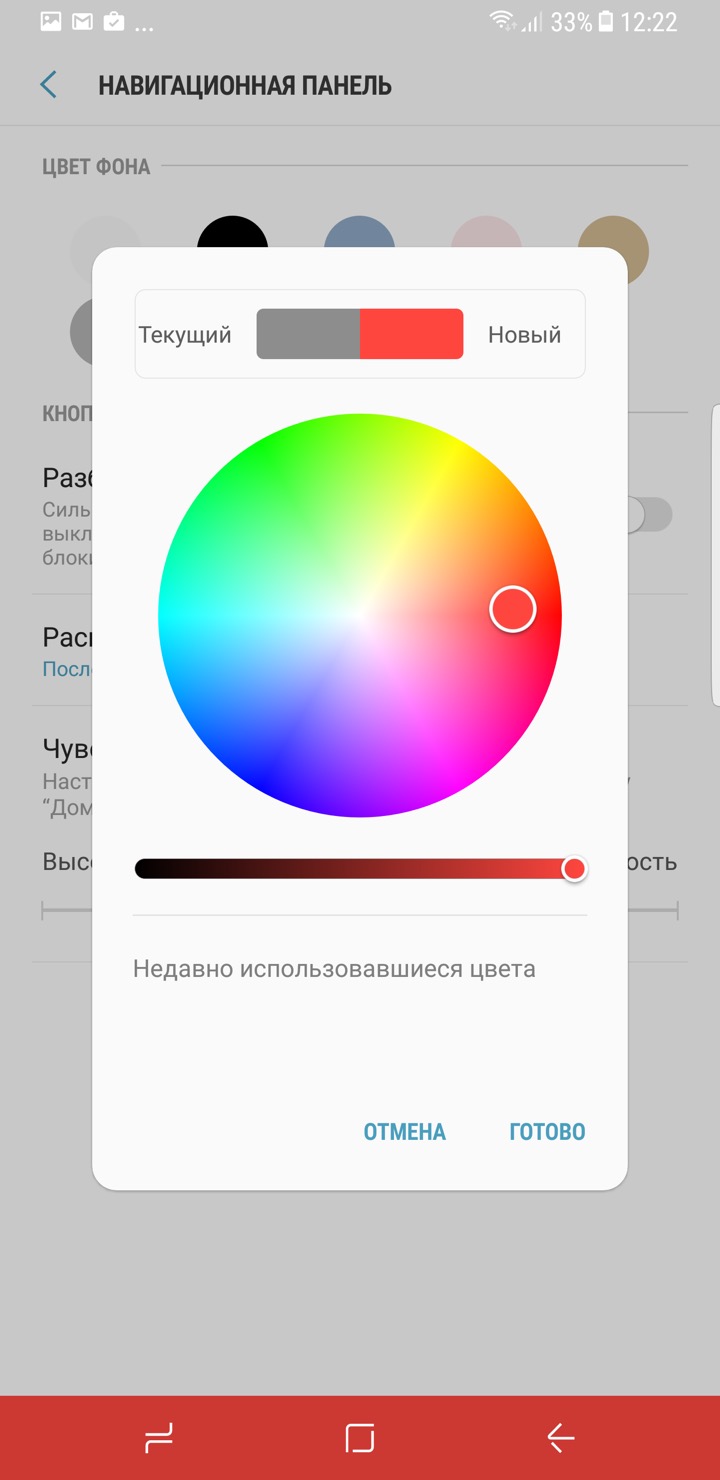
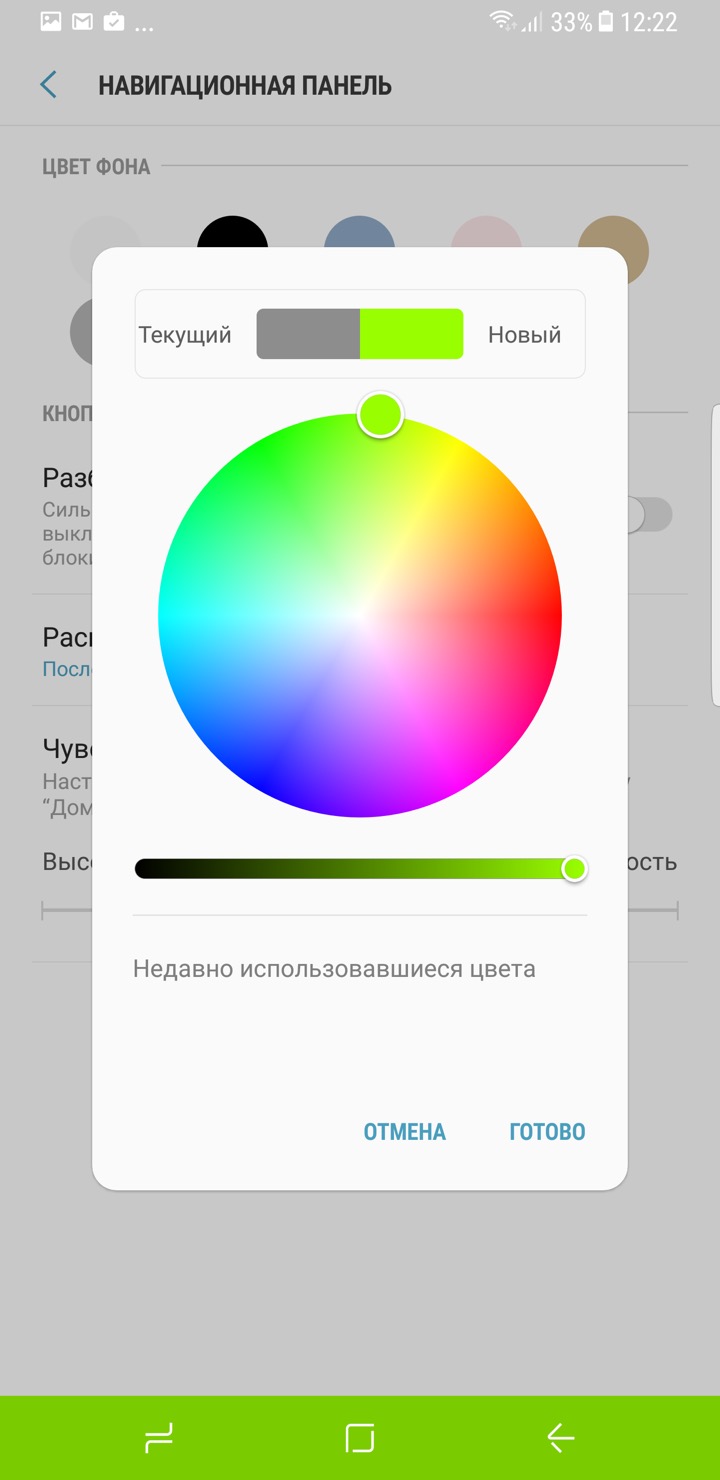
The Samsung Galaxy S8 offers a range of state-of-the-art radios, all of which work perfectly, as they should in flagships. An important difference was the presence of Bluetooth 5.0 - this is the first smartphone with this generation. Its features, in addition to the range, include a wider data transmission channel, due to which two pairs of wireless headphones, which is useful, for example, when watching movies together on a trip.
The quality of the external speaker is okay: it's still another output source that delivers decent volume and adequate stream clarity even at maximum, but overall the result isn't the best on the market (which is to be expected due to moisture and dust protection). The same can be said about playback through headphones - you can listen to music, the volume is enough, but the novelty does not reach the best representatives with a cool DAC. The overall situation is partially compensated by the built-in equalizer:
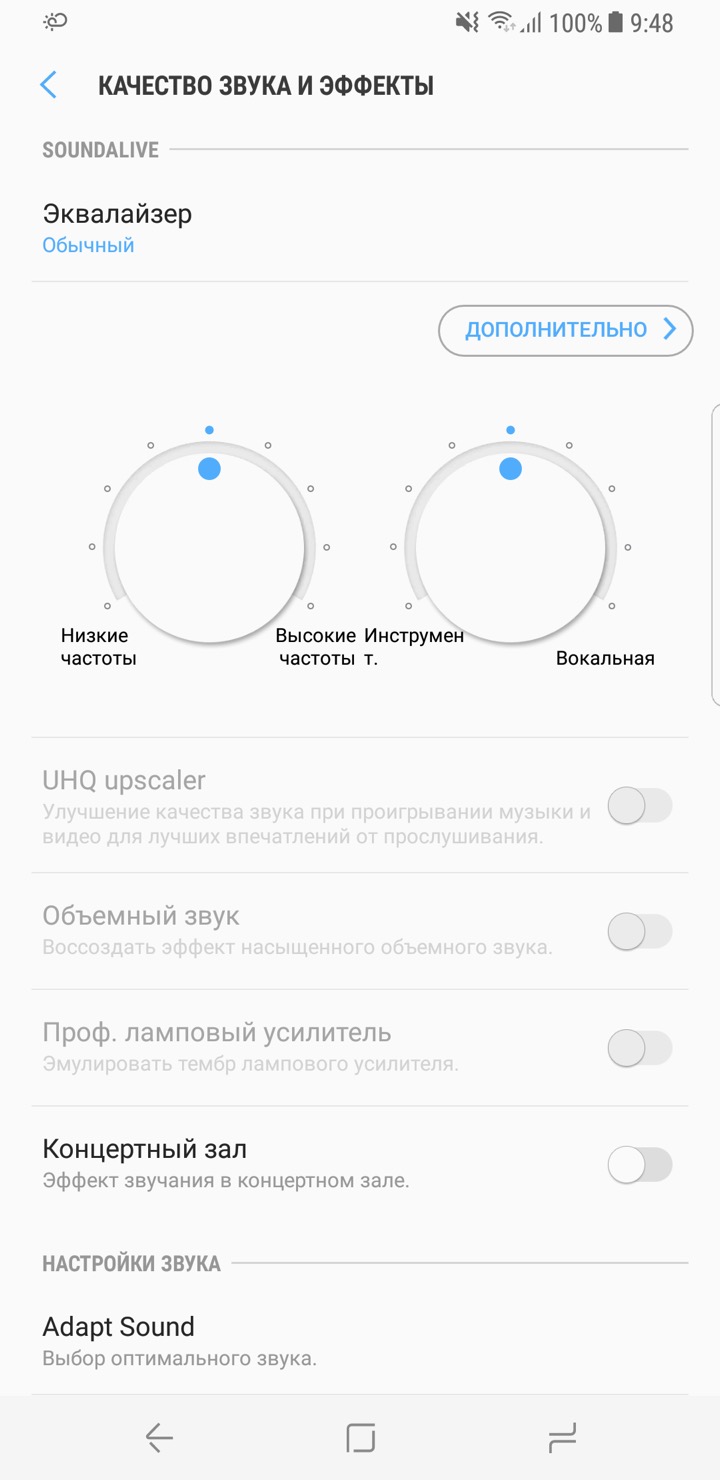
The central home button is located on the pressure-sensitive part of the display, which is necessary for retraining people who are used to a physical key with a physical response. The area always works, even when the screen is off and in cases where the button icon is not active. Parallel to the tapping, the machine delivers a vibration that is still nowhere near as accurate as the iPhone's Taptic Engine, but much nicer than the rattling motor found in most other smartphones.
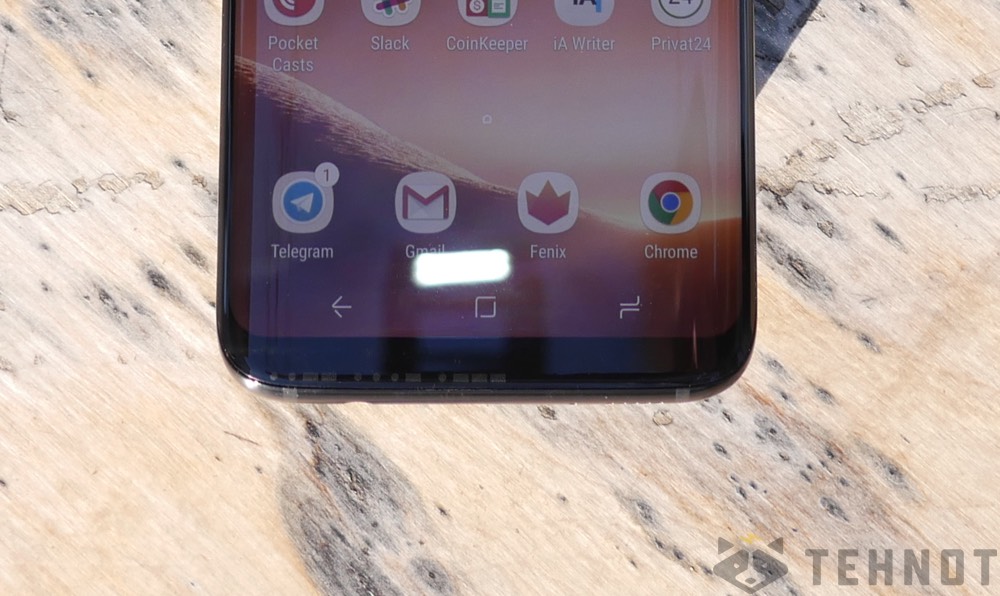
Most of the functions are convenient, all worked without any failures. The main software innovation, the manufacturer himself calls Bixby assistant.
bixby
Samsung has entered the battle of smart assistants, for which it has built Bixby into the shell and even added a separate physical key to launch it. Unlike competitors that act more like a knowledge base and allow you to use the functions of a smartphone at the simplest level, Bixby works on three fronts at once.
First of all, this is a voice interface for controlling a smartphone. He knows how to manage settings and content on a smartphone - if you select several photos in the gallery and ask "Create a new album", the assistant will automatically collect frames and add the appropriate section to the albums. A representative of the company at the presentation gave an example when, while viewing a map, he called Bixby and asked the assistant to take a screenshot and send it to a specific person.
The second feature is Bixby Home, which opposes Google Now's "zero" screen (and takes the same place in the interface). Samsung's own development also collects up-to-date data in the form of cards, pulls up weather information and forms a news agenda, and also knows how to work with several programs. So far, this is mostly branded software, but the manufacturer is already working with third-party developers who will add support for Bixby.

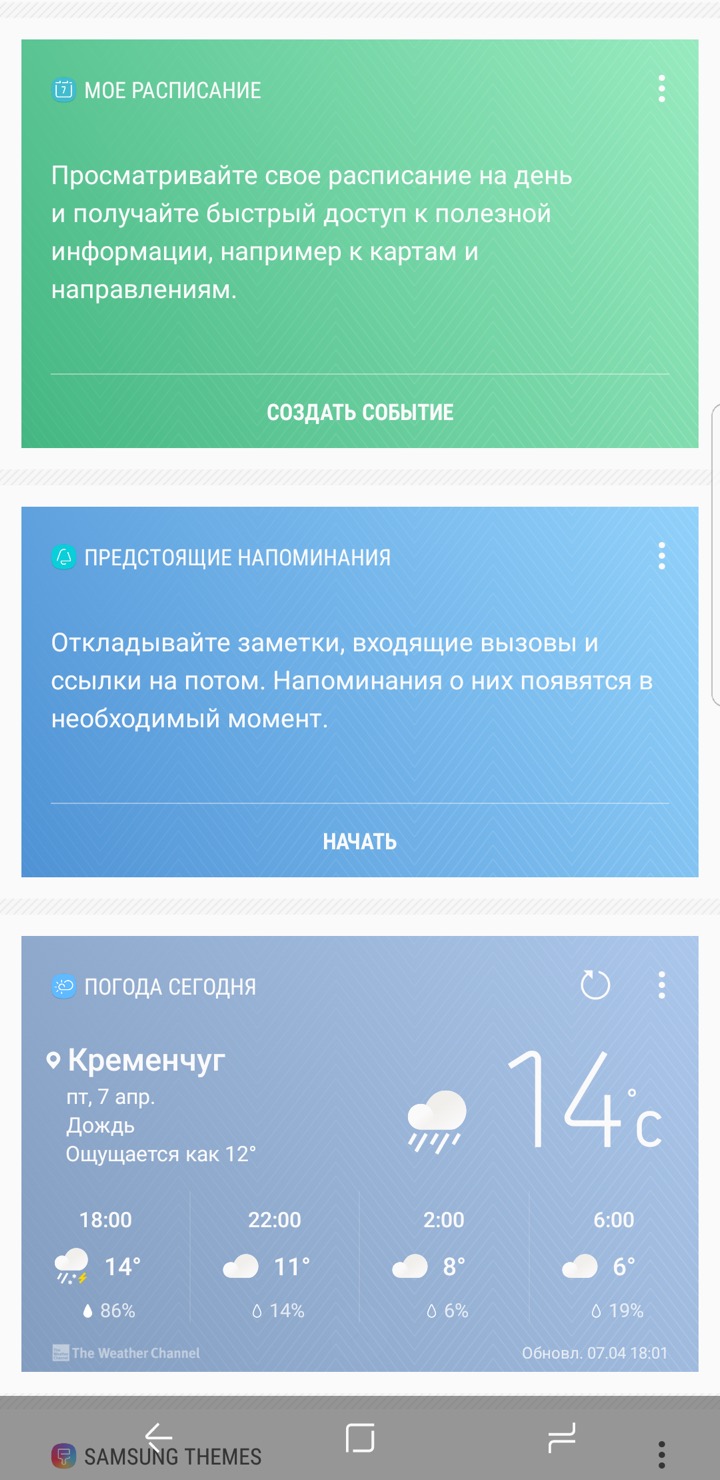
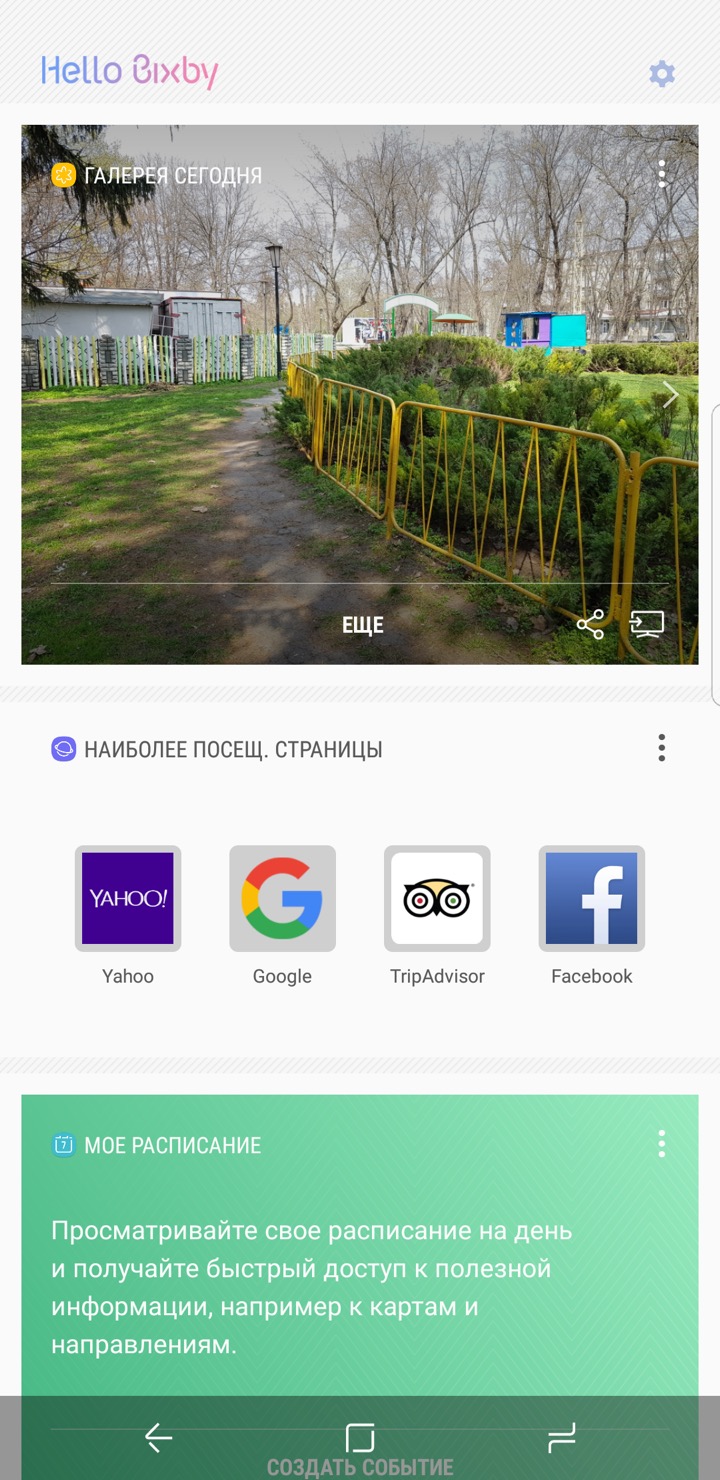
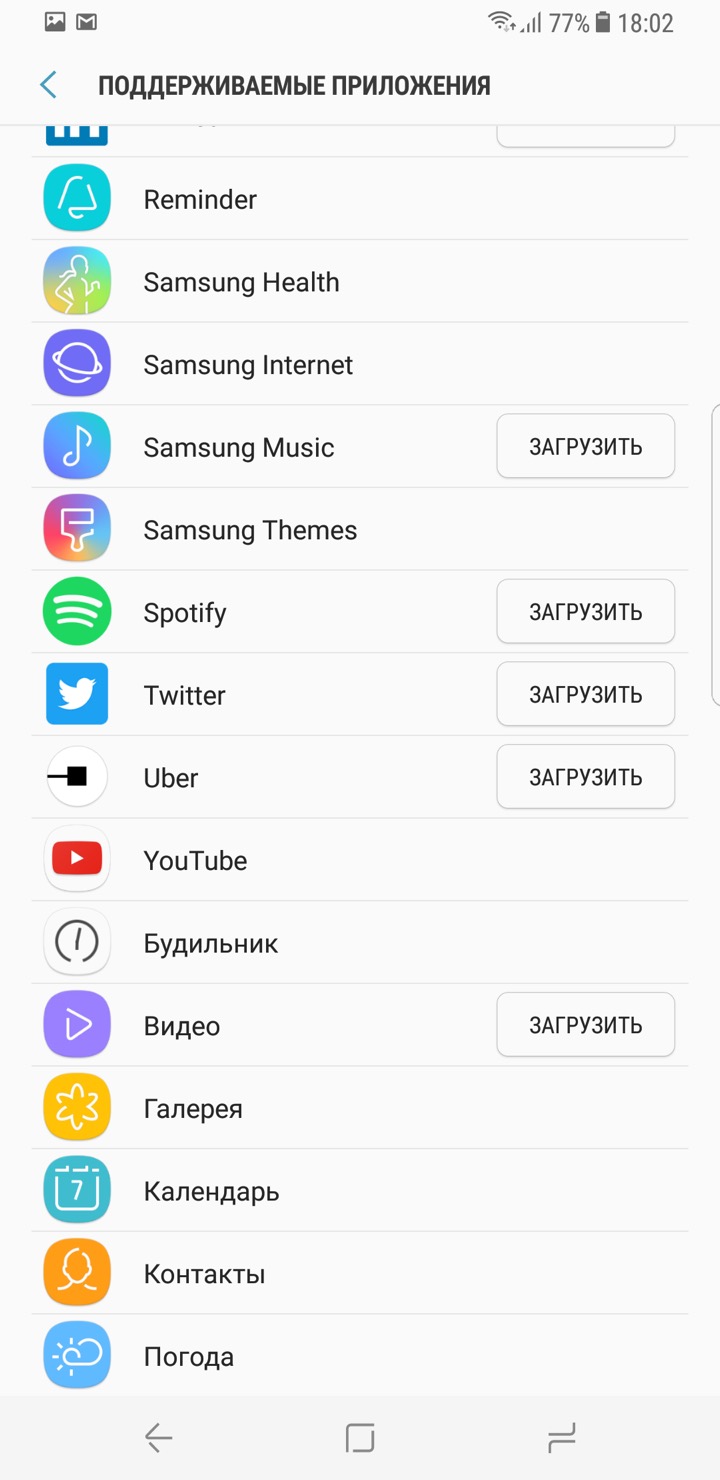

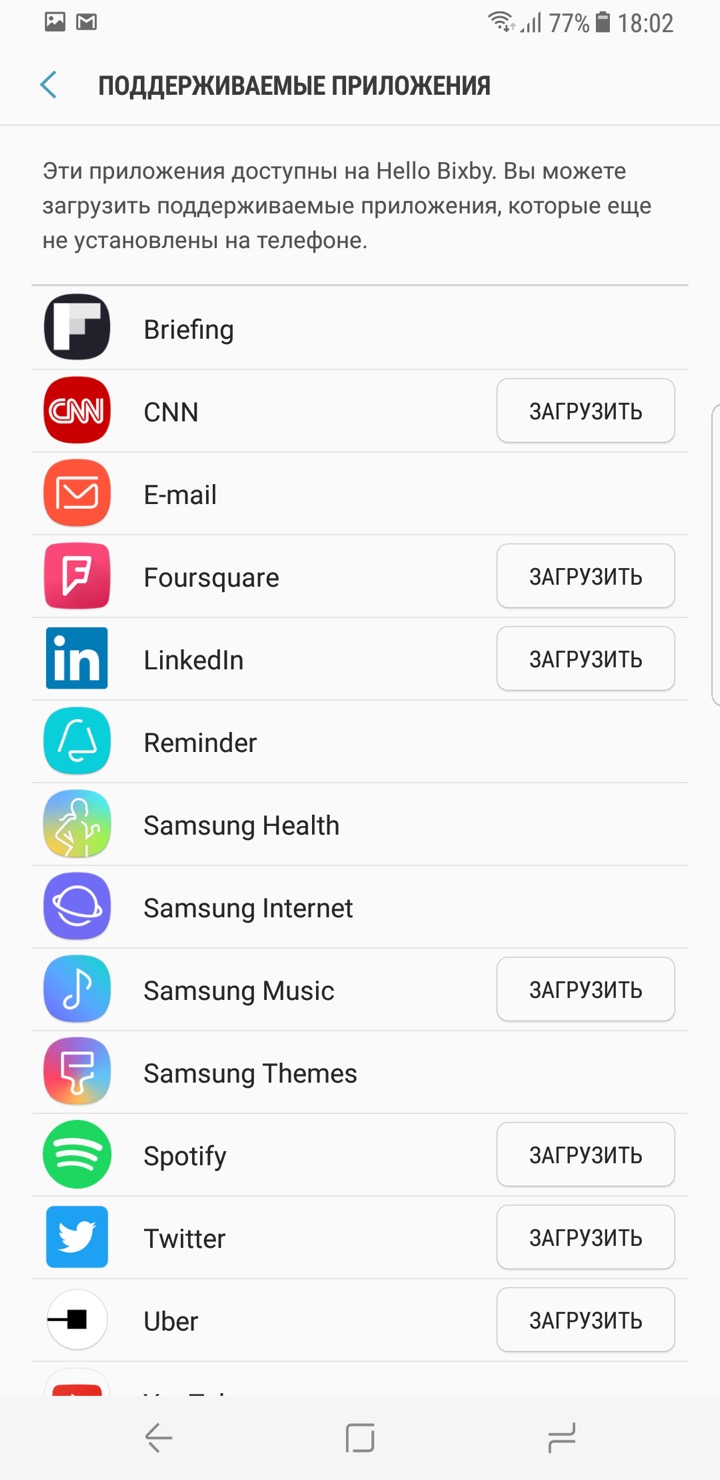
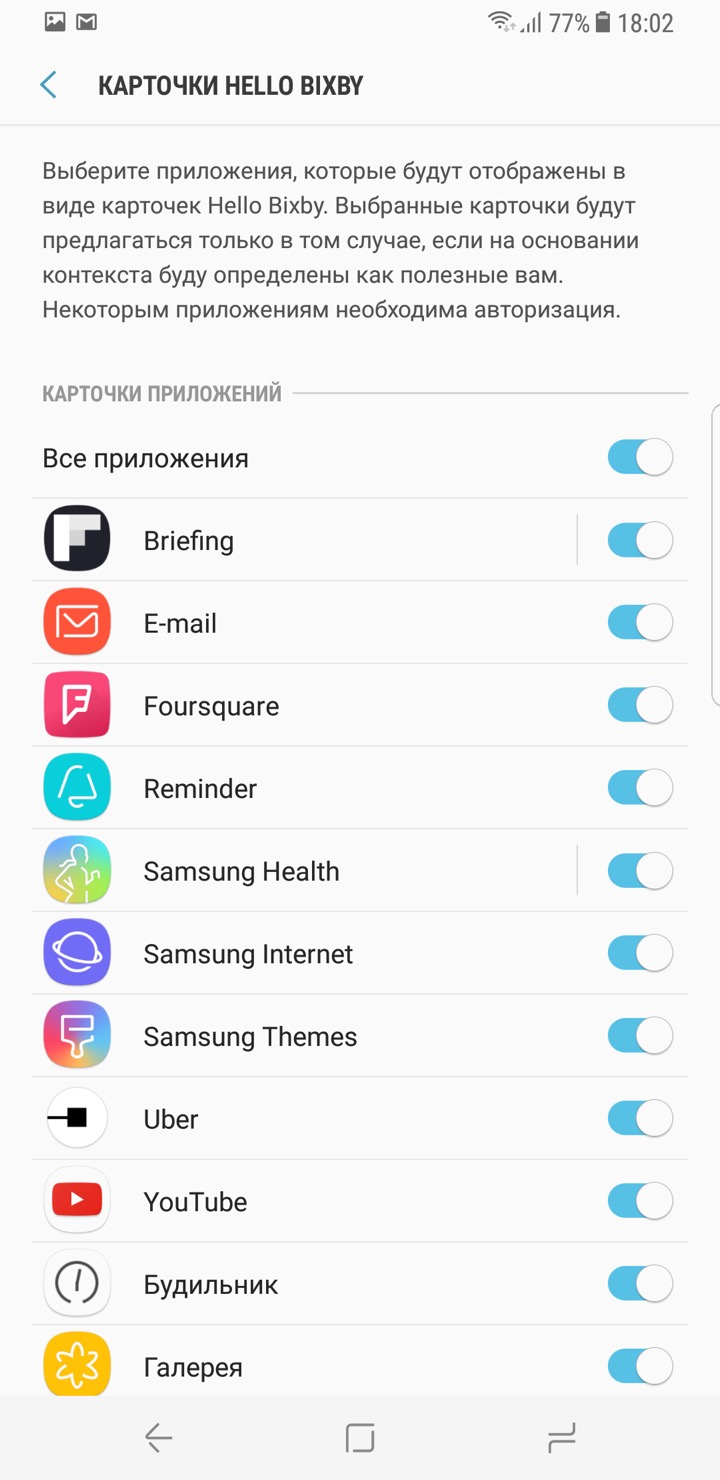



The third "trick" is Bixby Vision. This is a search function using the camera: point your phone at an object and see options for what you can do with the image. At this stage, the program recognizes places, text and tries how it does google app Goggles, identify objects. The latter, in theory, will allow you to find the desired shoes, information about drinks and other information, but so far in 95% of cases, attempts to “scan” something lead to a set of similar images or offer to guess which place is indicated in the photo. The latter feature relies more on GPS and data from Foursquare.
Text recognition does not work very well when compared with specialized software from the same ABBYY or Readdle or " Google Translate". It is the latter that you think about the first time you see the possibilities: to digitize the text or to translate it. The accuracy of the work suffers mainly from distortion, ranging from the wrong perspective to the shape of the bottle when trying to read the label. In the future, programmers will probably significantly improve algorithms or buy a company that has already learned how to read text from pictures well.
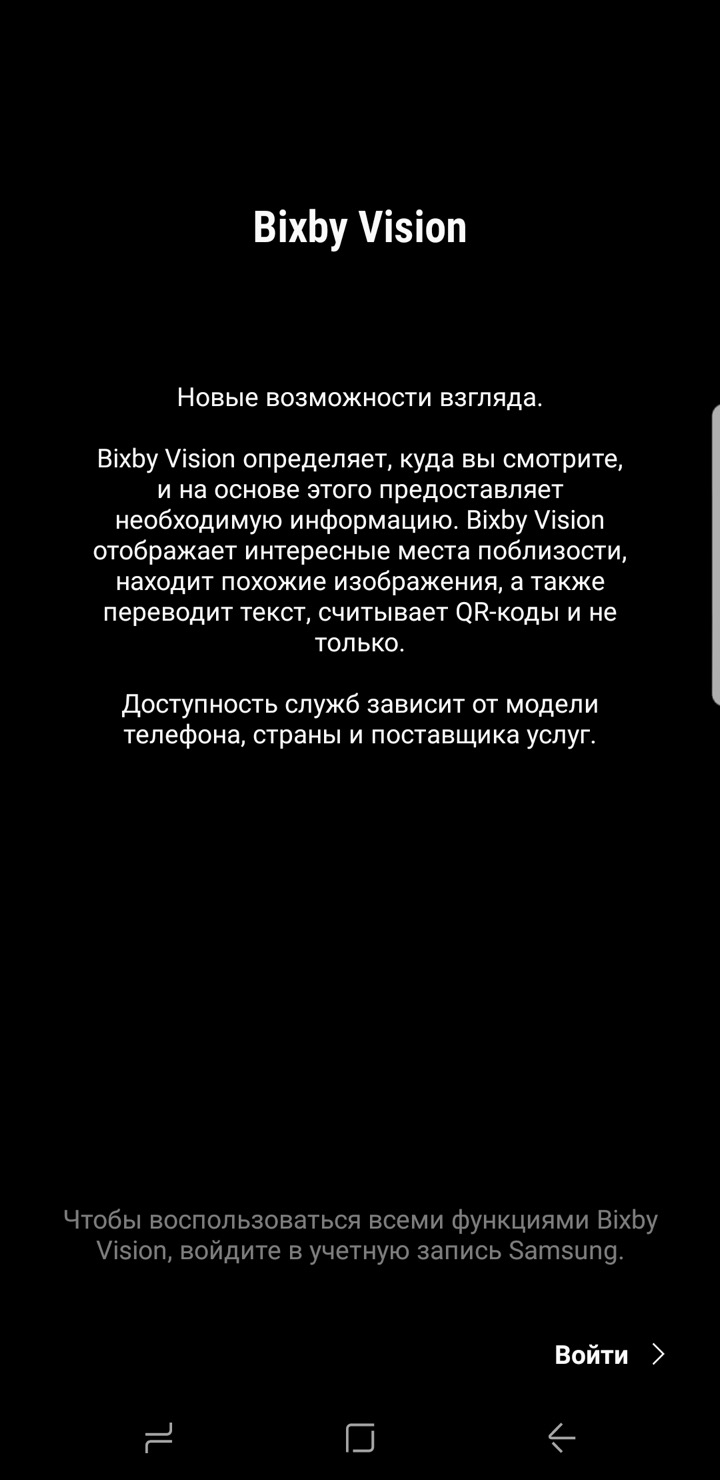





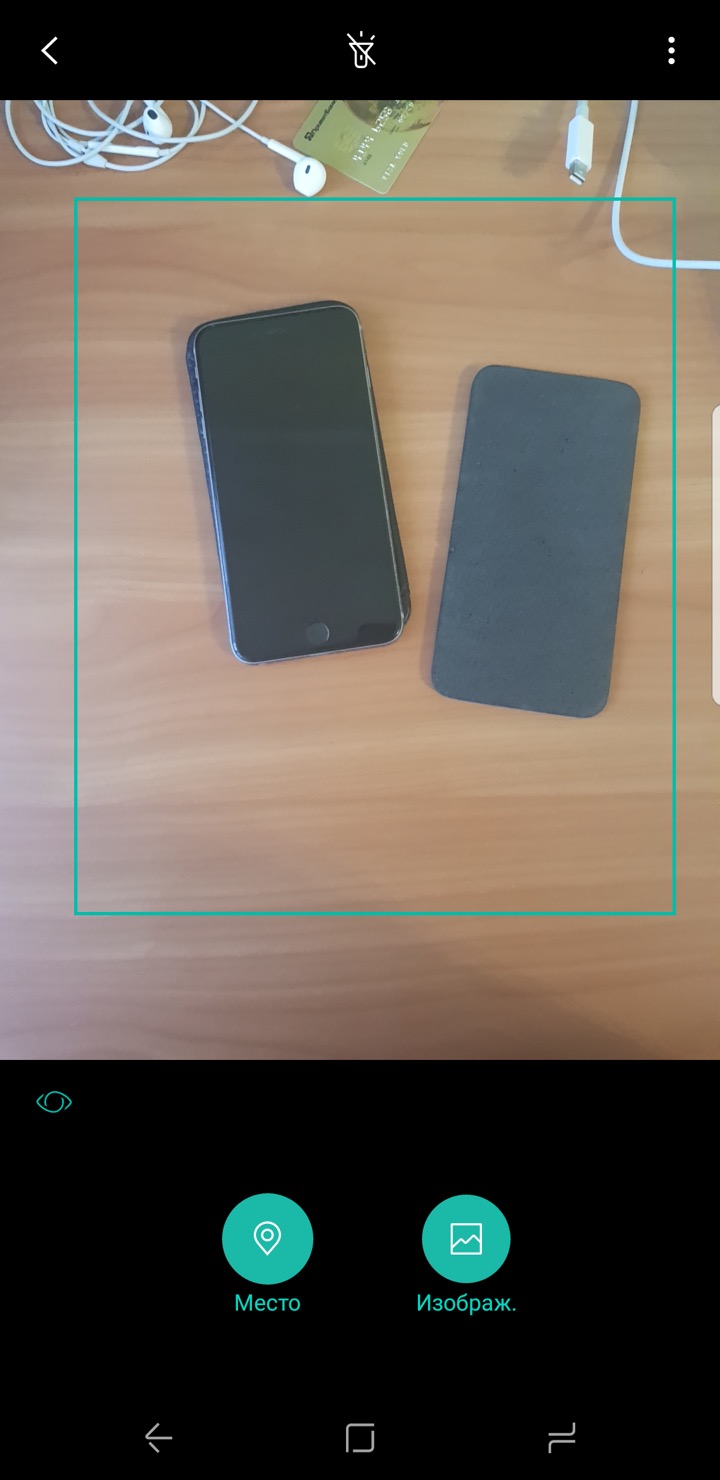
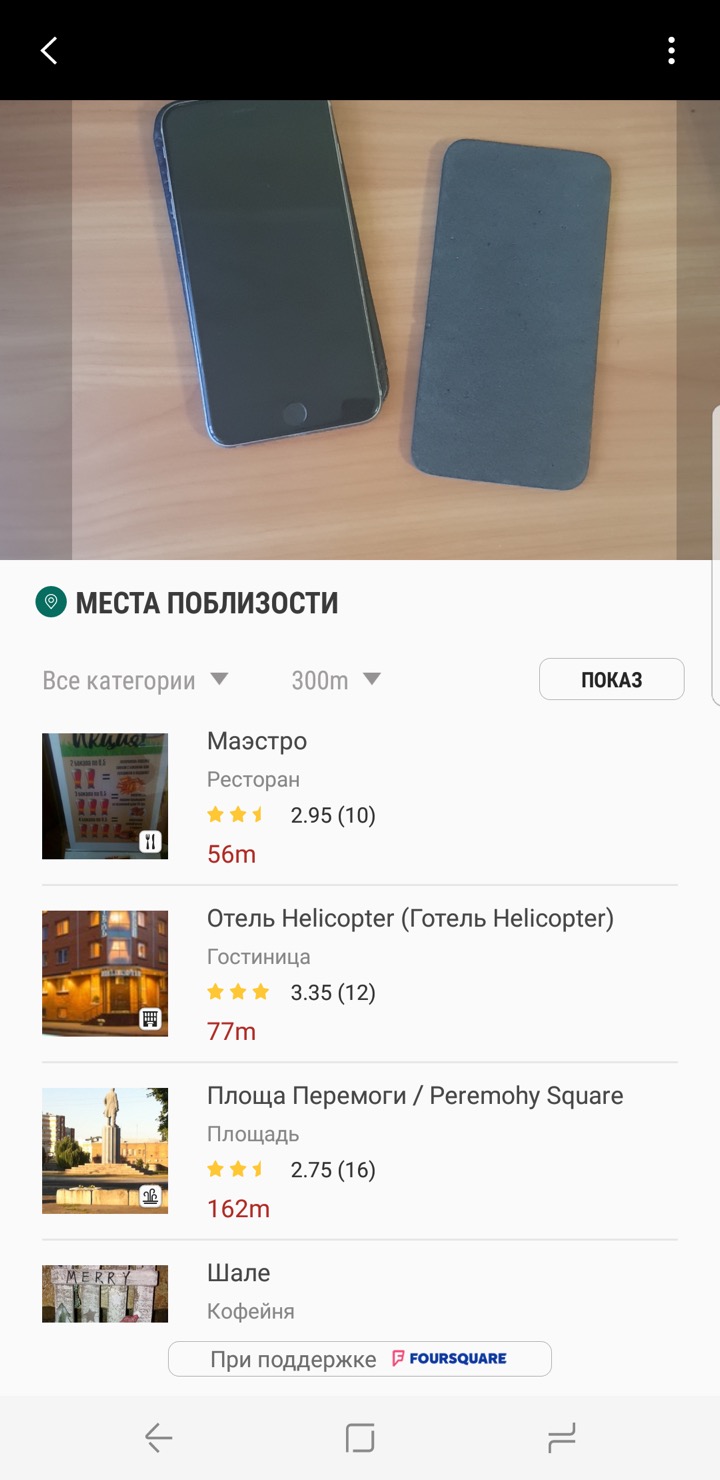
All the features of Bixby look interesting, especially considering that the program combines the functionality of several services and programs. The main problem is the remark “will be” to each of the possibilities, and the voice assistant is activated after the start of sales (only in the US this will happen by the end of April). So far, it’s not worth talking about Bixby’s serious competition with other assistants, but if the engineers don’t calm down on current achievements, in six months or a year Bixby may become another serious reason to buy Galaxy.
Competitors
Samsung Galaxy S8 and S8+ are available in Ukraine with only one modification: with 64 GB permanent and 4 GB random access memory. The cost of the devices is UAH 24,999 and UAH 28,999, respectively (the sales start will take place on May 5, 2017, but there is).
The actual price is higher than the Galaxy S7 and S7 edge at the start of sales, but the amount of memory has doubled, and AKG headphones are also included
The main competitor to the new products will be last year's Samsung Galaxy S7 edge: curved edges of the display, almost the same camera, comparable performance in everyday tasks, close autonomy. The novelties are only more convenient due to the not so strong bending of the screen, they look fresh thanks to the “borderless display” and please with the absence of a logo on the front side. But the difference in price is significant - S7 edge is sold for 19,999 UAH in official retail, and if you don't care about the bending of the screen, there is almost the same Galaxy S7, available for 17 thousand UAH.

Also, buyers can think about the choice between new products and semi-annual iPhone 7/7 Plus. Apple smartphones vs. new Samsung lose in most objective indicators and can only give two arguments: modifications with a large amount of permanent memory, iOS. Moreover, the last feature is too narrow - who seriously clings to the system, has been using iOS for a long time and does not switch to Android, the same thing happens in the opposite direction. To whom it doesn’t matter, they don’t think about it at all, because there are popular programs on both platforms.
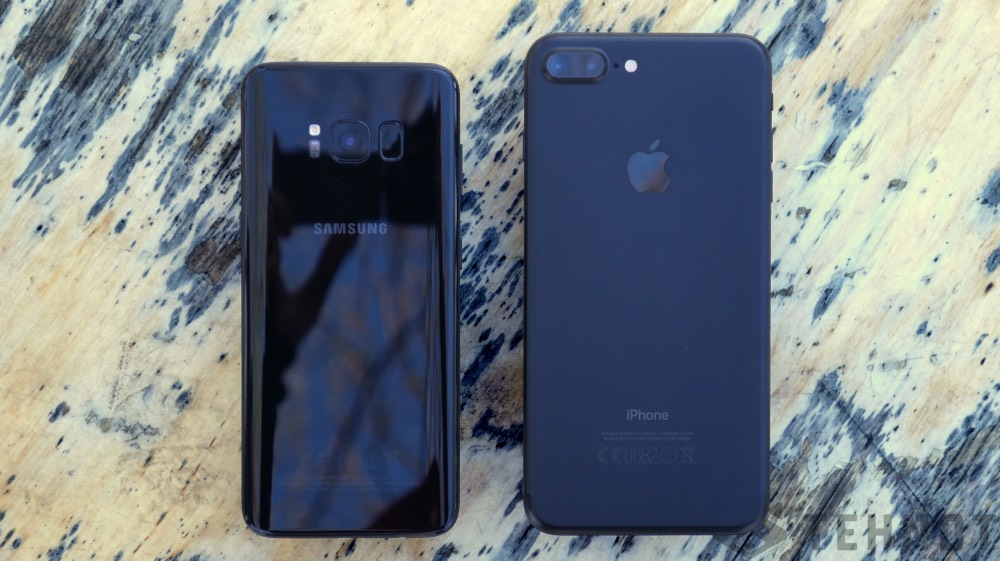
Also, buyers can pay attention to the less spectacular LG G6. This smartphone is not as productive, its camera, judging by the first tests, is inferior to Samsung, and among the theoretically attractive features, one can only note a more practical metal case. The display here is also elongated, but there was a place for the logo. But LG's flagship is cheaper - "only" UAH 21,999.
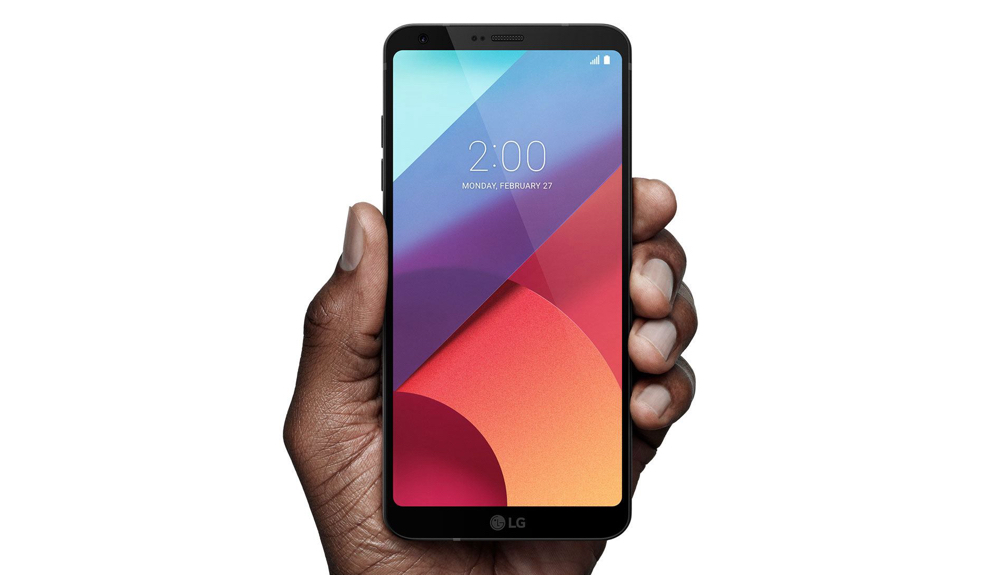
conclusions
Samsung remains the market leader and once again takes the status of the “main Android smartphone” - the Samsung Galaxy S8 turned out to be more convenient than the previous generation due to the not so sharp bevel of the frames and the symmetrical bend on both sides, the appearance has become more spectacular, especially due to the display almost on the entire front surfaces.
The technical features of the device, traditionally, are on top: a high-quality display, a powerful filling, the most modern radio modules, a large number of additional features and all the relevant “chips”, whether it is moisture protection or an iris scanner. The software device has also evolved: there are more and more functions, the interface is getting prettier, algorithms are squeezing the maximum out of the actually old camera, sufficient to call it a serious step forward.
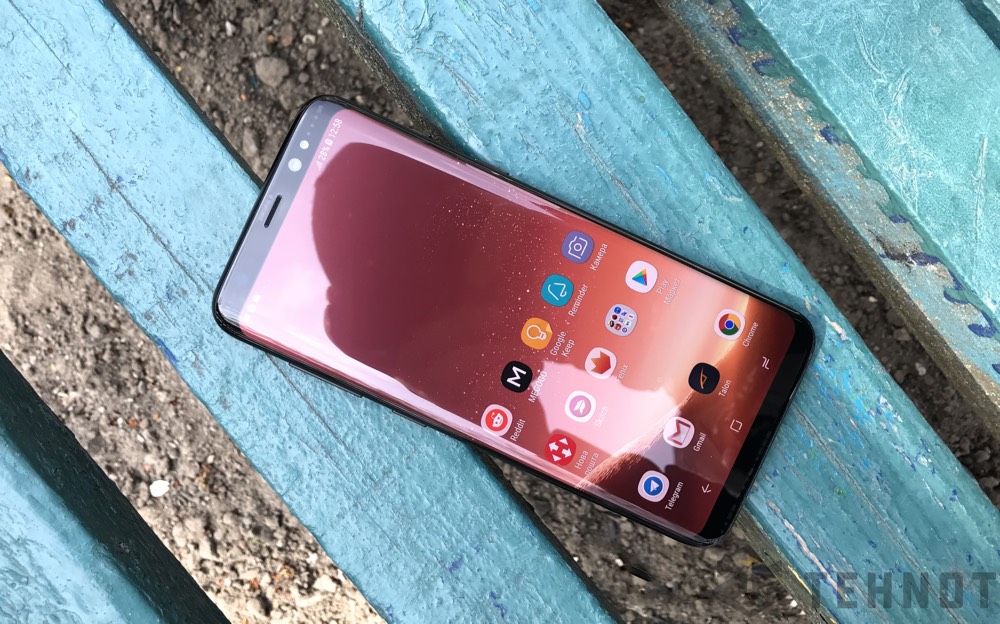
Competitors cannot offer all the features found in the Galaxy S8. This is a great device, next to which any device looks like catching up. Minor roughness is still observed, but this is true for any smartphone on the market. Progress is immediately noticeable, and not marking time.
Samsung Galaxy S8 is the right flagship of 2017: productive, beautiful, with a cool camera and full "minced meat", expensive. It is unlikely that someone will show a more interesting device in the coming months, so we can assume that the Galaxy S8 and S8 + will remain the most technologically advanced devices on the market at least until the release of the new Note.
5 reasons to buy Samsung Galaxy S8:
- spectacular design
- best camera on the market
- excellent performance and minimal heating
- the whole spectrum additional features in one device
- it's not an iPhone
2 reasons not to buy Samsung Galaxy S8:
- flagships are expensive
- it's not an iPhone
Flagship smartphones are always the most interesting models. After all, they best reflect the level of development of smartphones at the moment. In this article, we have prepared a short overview of the most popular flagship smartphones of 2017.
Samsung Galaxy S7 and Galaxy S7 Edge
A review of the flagship smartphones of 2017 should start with the Samsung Galaxy S7 smartphone. A new version of this smartphone appears every year and is expected no less than the iPhone. This year new flagship from Samsung received what many fans of this brand have been waiting for so long. Namely, a quality premium case. Now samsung case Galaxy S6 is made almost entirely of glass and metal.
Another unique feature new version flagship from Samsung is a modification with curved edges. This version of the smartphone has the Edge prefix in its name and is distinguished by the fact that the side edges of the screen are slightly curved towards the end of the device. How convenient such a solution in work can be said only by turning the device in your hands. But, in any case, this is at least a demonstration of the technological capabilities of Samsung.
As for the technical characteristics of the device. That, as always, they are on the very high level. The gadget runs on eight nuclear Samsung processor Exynos 8890 with MALI T880 MP12 graphics accelerator, a modification with a processor will also be available in some countries Qualcomm Snapdragon 820. The amount of RAM is 4 gigabytes, the amount of internal memory is up to 128 gigabytes. The screen of the device is almost the same as in the Galaxy S6, its diagonal is 5.1 inches, and the resolution is 1440 × 2560 pixels. The front camera has also not changed, its resolution is 5 megapixels. The resolution of the rear camera has decreased, now it is 12 megapixels. Battery capacity 3000 mAh.
For lovers of curved screens, as always, there are Galaxy version S7 edge.
Apple iPhone 6s and Apple iPhone 6s Plus
Apple iPhone 6s and Apple iPhone 6s Plus are already last year's flagships, but until the release of the new version of the iPhone, they remain full-fledged flagships.
The main feature of the sixth generation iPhone, of course, was the screen size. Apple finally went to a significant increase in the diagonal of the screen. The Apple iPhone 6 has a 4.7-inch screen (750×1334 resolution), while the Apple iPhone 6 Plus has a 5.5-inch screen (1080×1920 resolution). Screen sizes and resolutions have not changed on the Apple iPhone 6s and Apple iPhone 6s Plus models.
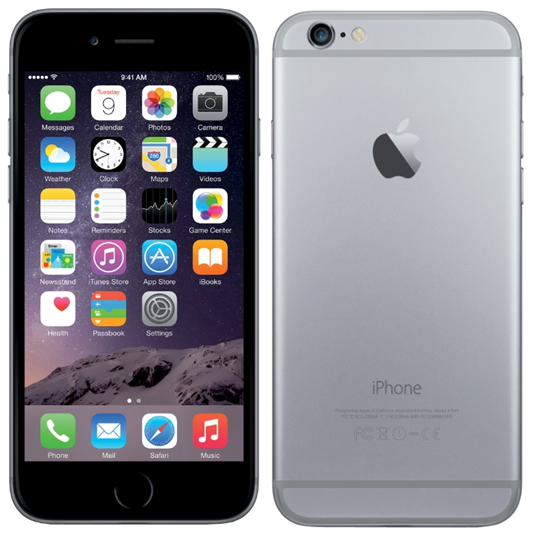
Technical iPhone specs 6s and iPhone 6s Plus do not break records. But, this is quite typical for Apple products. It uses a dual-core Apple A9 processor with a clock speed of 1.8 GHz and 64-bit architecture. PowerVR GT7600 graphics accelerator. The amount of RAM is 2 GB, and the amount of internal memory up to 128 gigabytes. The main camera is 12 megapixels, the front camera is 5 megapixels. Battery capacity 1715 mAh.
HTC 10
In 2016, HTC released another modification of its metal flagship. This time the novelty is called HTC 10.
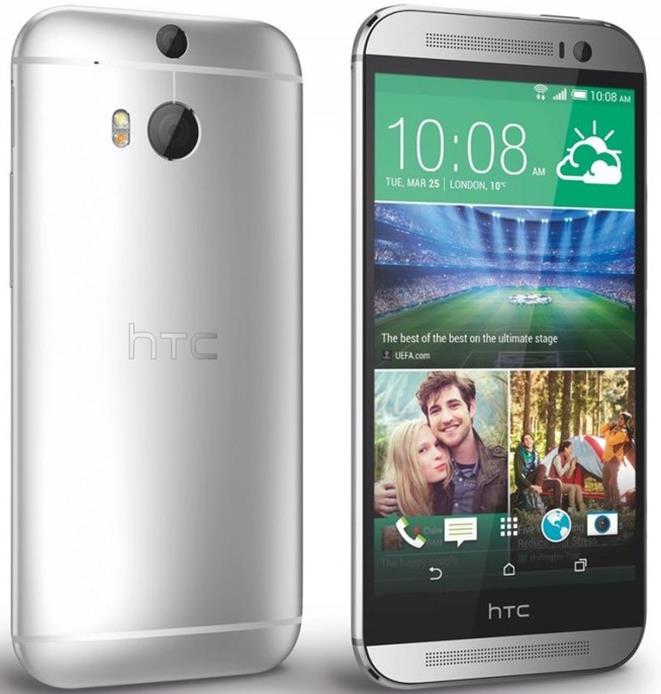
HTC 10 is a typical 2016 flagship smartphone. It uses four nuclear processor Qualcomm Snapdragon 820 with Adreno 530 graphics accelerator. 4 GB RAM, up to 128 GB internal memory. The screen has a diagonal of 5.2 inches and a resolution of 2560 × 1440 pixels. Rear camera resolution 12 megapixels, front camera resolution 5 megapixels. The battery capacity is 3000 mAh.
Huawei Nexus 6P was introduced last year, but in 2016 it can still be considered a flagship smartphone. This time Google entrusted the production of its flagship smartphone to Huawei. Recall that earlier Nexus smartphones were produced by LG and Motorola, and even earlier by Samsung.
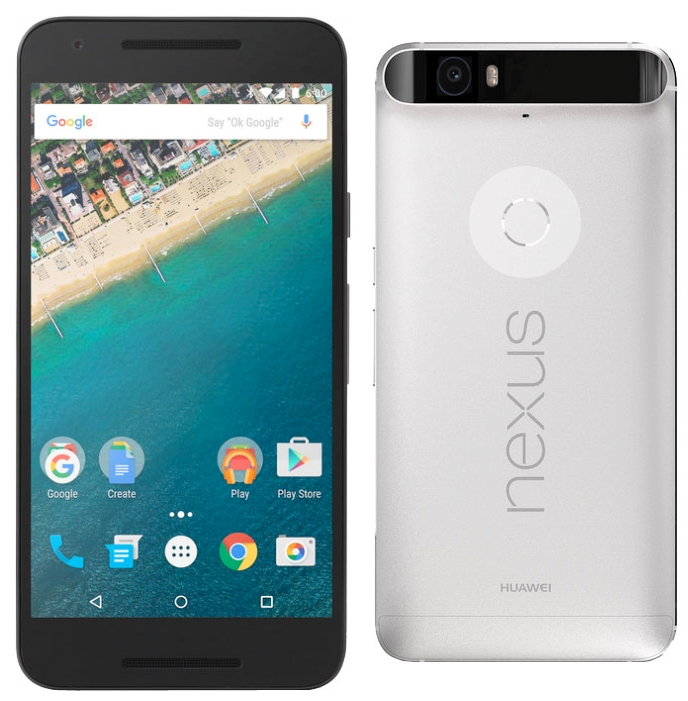
The Huawei Nexus 6P offers top-end specs that rival those of other flagship smartphones of 2016.
It uses eight nuclear Qualcomm processor Snapdragon 810 with Adreno 430 graphics accelerator. The amount of RAM is 3 gigabytes, the amount of internal memory is up to 128 gigabytes. The screen of the device received a diagonal of 5.7 inches, and its resolution is 1440x2560 pixels. Permission front camera 12 megapixels, rear resolution - 8 megapixels. There is also a good battery with a capacity of 3450 mAh.
Sony Xperia Z5
Sony Xperia Z5 - was introduced at the end of last year. But, Sony has not yet introduced a new phlegman in 2016, so consider Xperia model Z5.
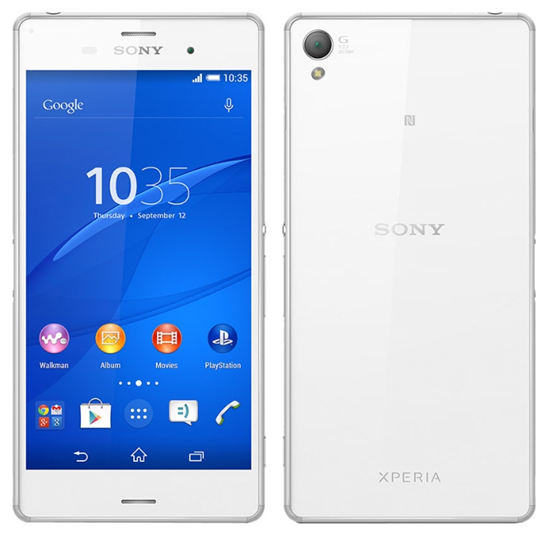
As always, the main advantage of the Xperia Z line is security. No other flagship smartphone has the same level of protection as the flagships from Sony. These smartphones can be submerged, thrown into sand or dust, and nothing will happen to them.
Sony Xperia Z5 received fairly typical characteristics. It uses an eight-core Qualcomm Snapdragon 810 processor with an Adreno 430 graphics accelerator. The amount of RAM is 3 gigabytes. The screen diagonal is 5.2 inches, and the resolution is 1080 × 1920 pixels. The resolution of the main camera is 23 megapixels, and the resolution of the front camera is 5 megapixels. The battery capacity is 2900 mAh.
LG G5
The G5 is the new flagship smartphone from LG. The main feature this device became a modular structure. The lower part of the smartphone can be removed and replaced with another one that will give the smartphone additional features. For example, this way you can get a more advanced camera.
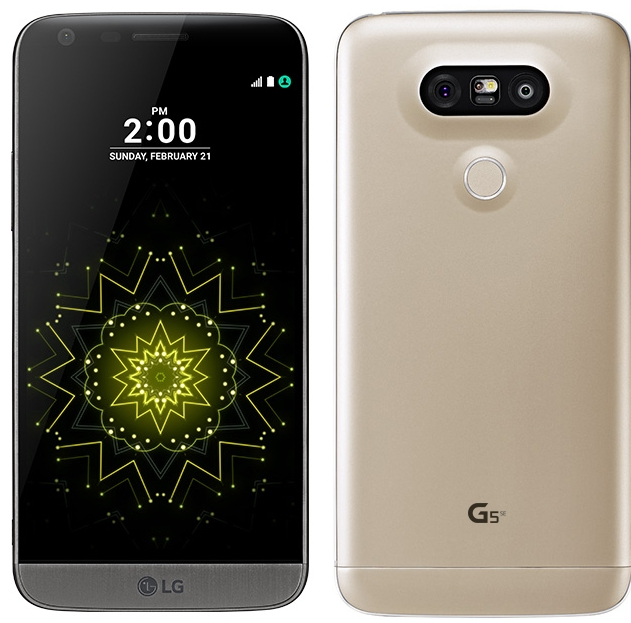
Otherwise, this smartphone does not stand out. It uses a quad-core Qualcomm Snapdragon 820 processor with an Adreno 530 graphics accelerator and 4 gigabytes of RAM. The screen diagonal is 5.3 inches, and the resolution is 2560 × 1440. The rear camera received a resolution of 16 megapixels, and the front 8 megapixels. Battery capacity 2800 mAh.
Most smartphone manufacturers highlight top-end devices in their product line that they pin their hopes on. Such devices are usually called flagships. The flagship is a smartphone that is distinguished by advanced functionality and equipment that surpasses other models of the manufacturer. The term has migrated from the navy, where the flagship is the most powerful ship in the squadron, on board of which the command is located.
Flagship - does not necessarily combine all the best of mobile world. If the manufacturer is engaged in the production of budget handsets (like many Chinese companies), then the flagship can also correspond to the middle class. This state of affairs can be observed, for example, in Philips or Fly. Their tops can only compete with the "average" Samsung or LG. Nevertheless, these are full-fledged flagships against the backdrop of the most massive low-cost smartphones for 100-300 dollars.
In their advanced smartphones, manufacturers strive to embody all the achievements and new technologies that are ready for practical application. If the company has its own powerful research base, then the latest developments are used. Firms that use components from third-party developers do not have access to them. In this case, the best parts that are freely available are used. Processor suppliers are companies such as Qualcomm or MediaTek, memory is purchased from Samsung, Hynix or Elpida, and displays are purchased from Sharp, Samsung, JDI or LG.
Samsung flagship series
Samsung is the number one flagship manufacturer in the smartphone world. Top-end devices of the company are such not only in the model range of the manufacturer, but also in the whole market. This is possible thanks to the concentration of huge resources, the presence of its own divisions for the development and production of components, as well as large-scale financing.
Samsung installs the fastest RAM and permanent memory in its flagships, latest processors Exynos Octa, Ultra High Definition (2.5K) Super AMOLED screens and quality cameras. All these details of smartphones are made by Samsung independently and are not available to other companies until the jackpot is hit with sales of new products.
Samsung flagship series from Galaxy S (2010) to Galaxy S6 (2015)
Samsung's flagship line is Galaxy smartphones S. Top phablets belong to the series Galaxy Note. It is in these smartphones that the main achievements are concentrated.
Flagships from Apple
Apple has a different approach in terms of releasing flagships. Unlike the same Samsung, the company does not have its own production facilities. Components are supplied by third-party contractors, they are also involved in the assembly. As a result, Apple does not have the opportunity to put the most advanced parts. Yes and the lineup, against the background of competitors, looks more modest. Therefore, there are no obvious flagships among the iPhone. Almost every iPhone (with the exception of models positioned as budget, like 5C or SE) can be called a flagship.
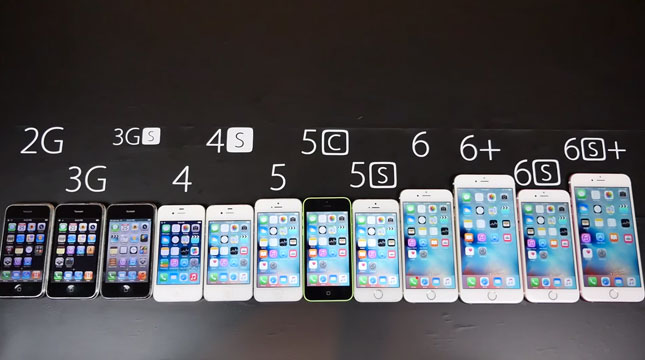
Not having the opportunity (and even a special desire) to implement new technologies “in the forefront”, Apple prefers to work on the quality of implementation. The company's policy is that it is better to deliberately implement a proven technology than to experiment with a new one and "catch" bugs in it. Therefore, the iPhone is the flagship, despite the fact that “on paper” its characteristics can be attributed to the middle class at most.
Other flagship smartphones
LG launches flagship smartphones in the G line, where it also embodies cutting-edge developments in the field of screens and cameras. Sony promoted the Xperia Z series until 2016, which also installed best displays(up to 4K) and cameras (up to 22 MP) of our own production. Now the flagship has become Xperia series x.
Other companies do not have such a powerful production and research base, therefore they are forced to use third-party developments. The only exception is Huawei, which makes Kirin processors themselves. HTC until 2016 produced top smartphones in the One M series, but the latest flagship of 2016 is called the HTC 10, without additional letters.
The most difficult thing is to determine the flagships of the Chinese. If Xiaomi and Meizu are still easy with this (Mi and MX series, respectively), then Lenovo, ZTE, Huawei, Oppo do not release special series, which include only pronounced flagships. And a wide range of models does not allow unequivocally to single out the “most-most” smartphone of the company.
The new flagship smartphone Samsung Galaxy S8 continues to acquire details. At this point, almost everything is known about the hardware of the model that will replace the Galaxy S7 model. MacDigger decided to collect in one material all the features that the best Android smartphone of 2017 can boast of, as opposed to the iPhone 8.
According to rumors, Samsung intends to start selling the Galaxy S8 in March, but the flagship may be delayed until April. After Samsung recall Galaxy Note7, the company promised to make significant changes to the quality control system. Seoul simply can't afford to rush to market yet another device without properly testing it.
1. 5.5 inch 4K display
New flagship samsung phone is being developed by a manufacturer codenamed Project Dream. According to media reports, the company intends to equip it with a 5.5-inch AMOLED display and 4K resolution. The name of the project is a reference to the virtual reality platform Google Daydream. And sources say that this similarity is no coincidence, since the South Korean flagship will be optimized to work with virtual reality thanks to the display with a resolution of 3840 × 2160 pixels.
2. No home button
One of the key innovations in the Galaxy S8 will concern the main button of the smartphone. The device will lose the mechanical Home key in favor of a virtual one built directly into the device screen. The technology involves the use of an ultrasonic sensor, which will allow you to place a fingerprint scanner under the display panel and improve accuracy and speed compared to capacitive sensors.
3. 8GB RAM
According to online sources, the Galaxy S8 should be one of the first smartphones on the market with a record amount of RAM. According to insiders, Samsung will produce 8GB RAM modules for the flagship in-house using a 10nm process.
4. Flagship Snapdragon 835 processor
The smartphone will be based on the top Snapdragon processor 835 or your own Exynos 8895. In this case, the device can get a special super-performance mode. The Galaxy S7 already has Gaming and High Performance modes, and will be joined by a third Beast Mode. These functions will directly affect not only performance, but also time. battery life smartphone.
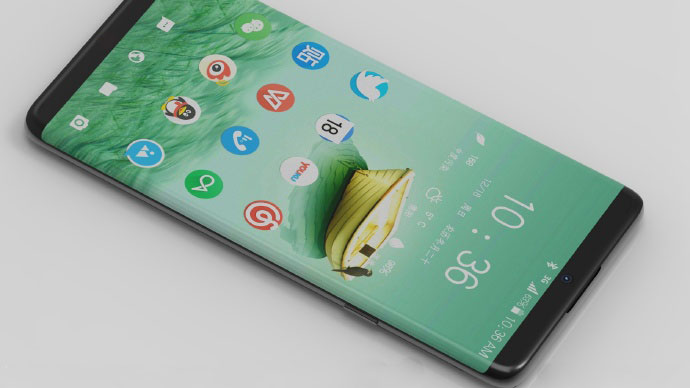
5.UFS 2.1 flash memory
According to reports, the G8 will receive a flash module of the UFS 2.1 standard. UFS, or Universal Flash Storage, is a general specification for flash drives for digital cameras, cell phones and consumer electronics. Compared to the widely used eMMC memory, UFS chips provide a significant increase in performance while reducing power consumption. The capacity of the UFS 2.1 module as part of the Galaxy S8 smartphone will reach 256 GB.
6. Dual camera
The new Samsung smartphone will have a dual camera module, which has become one of the main features of the iPhone 7 line. The main camera of the flagship will acquire a 12-megapixel sensor from Samsung's own production, as well as an additional 13-megapixel Sony module. Such a system will allow the device to use a different depth of field and improve the quality of shooting in low light conditions.
7. Touch sensitive display
The Samsung smartphone is credited with many different features that have not previously been seen on the market. There is nothing surprising here. Firstly, the excitement around the flagships of the Korean giant has always been high, and secondly, this time it is enhanced due to the situation with the Note7 model. According to unconfirmed reports, Samsung is considering the possibility of using chips of "apple" devices in the Galaxy S8 - a pressure-sensitive display. And the use of partial. Allegedly, the technology will “open up” completely in 2-3 years, but there is no specific information about this yet.
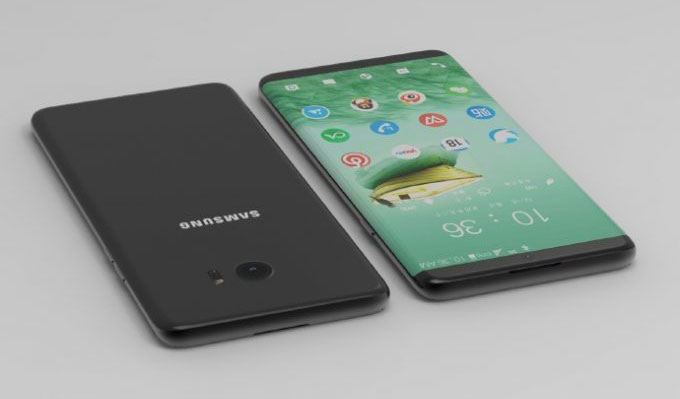
8. Stereo speakers
It is known that the Samsung Galaxy S8 after the iPhone 7 will receive stereo speakers. The smartphone will be the first representative of the line with this feature. Sources say the Galaxy S8's branded stereo speakers (like Boomsound on HTC smartphones) will be produced by a well-known player in this market, Harman.
9. S Pen
The Korean will be equipped with an S Pen. Support for pen input and the presence of a stylus in the kit seem especially appropriate in the case of the Samsung Galaxy S8 Plus version with a six-inch display. It is possible that the decision to start supplying the model with a pen Galaxy line S is associated with the intention to stop the development of the Galaxy Note line after the failure of the Galaxy Note7 model.
10. Voice assistant from the creators of Siri
Samsung plans to launch an artificial intelligence virtual assistant service that will be available to users of the Galaxy S8 smartphone. In October, the South Korean company announced it was buying the creators of Siri, who are working on the Viv virtual assistant. In Seoul, they hope that the virtual assistant with artificial intelligence will help regain ground lost due to the situation with the Galaxy Note7.
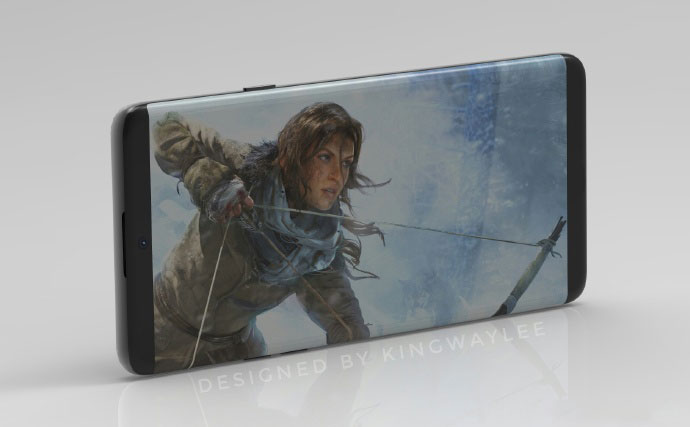
11.Bluetooth 5.0
Bluetooth 5 (Bluetooth 5.0) specifications were adopted in mid-December. The new standard differs from the previous one primarily in the increased communication range and data transfer rate. Samsung Galaxy S8 should be the first smartphone with this modem. There is no confirmation of this information yet, but we can recall that the Korean giant is part of the Bluetooth Special Interest Group, which is just responsible for developing the standards for this technology.
12. Without audio jack, but with wireless headphones
Together with the Galaxy S8, the company plans to release a new wireless headset, focused primarily on use with the new flagship. It is highly likely that the headphones will be bundled with the Galaxy S8, as the new flagship will be the most important product for the company in recent years. Samsung may well give up part of the profits for the sake of returning customer loyalty. It can also be assumed that the headphones will carry the Harman brand.
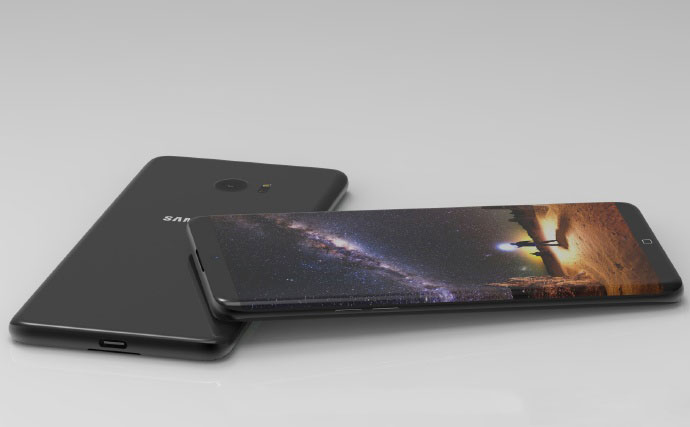
13. Will become even more expensive
Rumors indicate that the Galaxy S8 may be significantly more expensive than the iPhone 8. In particular, analysts at Goldman Sachs believe that the new flagship will be 15-20% more expensive than its predecessor. That is, the smartphone will be estimated at about $ 900. Of course for Samsung Galaxy model S8 will be the most important in recent years. And it is quite possible that the device will indeed be endowed with a large number of new technologies and functions. But exactly the same rumors about a significant increase in cost could be heard regarding the new Apple smartphones. As a result, only the iPhone 7 Plus went up in price, but only by $20.
14. With USB-C connector
For now, we're just talking about USB-C interface in the iPhone 8, but in the case of the Samsung device, they don’t see other options.
In the past two years or so, one word has become increasingly popular in the mobile industry: flagship.
The new flagship from Samsung. Which best flagship 2015? Is this the new flagship of company X?
It is used everywhere, and almost every new high quality smartphone called the flagship. But what is a flagship smartphone really? What does this term really mean? Are we using it correctly?
By Wikipedia, the flagship is the best model at the moment, most importantly, produced in a particular organization.
From this it can be understood that specifications does not determine belonging to the flagships in any way. Let's take the most good model from explay (Explay AIR) and with its meager characteristics, it is still a flagship, although it did not stand next to the same Samsung Galaxy S6.
Roots this term go to the navy. The word flagship originated as a naval term, used to describe the most important vessel in a fleet - or a vessel carrying a commander. It also explains why, especially in the mobile industry, the term has become so popular, and... overused.
If the flagship is the best and most revered ship in the fleet at the moment, then it is natural that the smartphone itself high class in the company is considered its flagship, right? In most cases, absolutely. But the term is losing its meaning, and not only because of the media.
About a month ago, everyone was waiting for the release of Lumia 730 and Lumia 830. And none of them even claimed to be the flagship. If Microsoft had not blurted out the slogan: "830 is the first affordable flagship."
What does this even mean, sorry Bill, but the Lumia 935 is more like a flagship, and it costs no less than the flagships of other companies? 
Speaking in terms mobile phones, or even more specifically from Samsung's point of view, which model can be called a flagship?
Samsung releases dozens of phone models every year. Of course, only a few stand out in an endless list. Samsung smartphones A: Galaxy S5 and S6, Galaxy Note4, and currently the Galaxy Alpha series of smartphones. Of these, the Galaxy Alpha is definitely not a flagship brand.
The other two are regularly called flagships, but that can't be right? There is only one flagship.
The flagship has become almost synonymous with "high-end" or "premium", it is not correct.
So how to determine such a smartphone - by specification, price, or sales volume. I think the flagship should not even be absolute best phone in the company line. I would say that the flagship smartphone is the one that brings the best profit, sells better than others.

